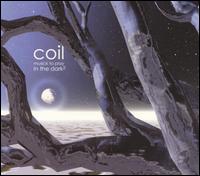Mira Calix – One On One
Label: Warp Format: CD,2LP
This record rocks, thats the simple way to put it. Other record labels must hate the way Warp casually goes about releasing albums that are just so damn good. One on One is the debut album of South African Chantal Passamonte, AKA Mira Calix, recorded in the seclusion of relatively icy Sheffield where she goes about her musical business as occasional in-house DJ for Warp.
OK, why is this album so good? Go buy it, thats the simple answer. Trying to describe what One on One sounds like is an exercise in futility. Each track would have to be broken down in turn. Mira Calix has a distinct style, but thats not to say each track is a variation on the same theme. Few electronic records have this much diversity; each track launches out into a new direction.As a general pointer, I could say it reminds me of fellow Warpsters Autechre, but that metaphor is becoming increasingly redundant these days. After all, pretty much every Electro track that isn’t a pumping dance floor filler tends towards Autechre emulation. Anyway, just as Ms. Calix looks like she’s heading towards the territories mapped out and then redesigned by Messers Booth and Brown, she breaks off abruptly and lays down some serious drones drenched with her digitised vocals. Comparison defeats the point, this is Mira Calix in her own right and she’s busy defining her own style of Electro.
Nne on One is ethereal at points, then it becomes mechanised, then all too human, then a whole host of other styles and impressions too long to list, an often all at once. Chantal Passamonte has produced a debut album that isn’t merely good, it’s better than that – it’s great.
-Les McQueen-
Campfire Songs – Campfire Songs
Label: Catsup Plate Format: CD
This was apparently recorded on a porch in rural Maryland with the bare minimum of equipment ; acoustic guitars recorded live on three mini-disc recorders and some field recordings added later. This is a very different approach to alternate group identity Animal Collective‘s earlier releases but it isn’t some kind of “American roots revisited” music. There are virtually indecipherable vocal incantations over hypnotic guitar strumming while sounds of the outdoors infiltrate these recordings in the form of bird sounds, wind and rain. I was briefly reminded of certain tracks by Set Fire To Flames.
It is in places a weirdly compelling, if somewhat fractured or dislocated sound. Guitars and voices pick up a theme and repeat it, varying and mutating it. This works best, for me, on the last track “De Soto De Son” where the vocals are nearly in harmony over the ostinato guitar figures. It creates an unreal soundscape reminiscent of open spaces peopled by the wraiths of drifters and lost souls. Disturbing and attractive by turns, it is something I couldn’t walk away from, though I can’t say I actually like it. Though I don’t think it really matters whether or not you like some music, you just know it works and is saying something that you have to listen to. It becomes a little more amorphous and abstract as it progresses before returning to those near harmonies and mellifluous pluckings.
If you wont a little lo-fi music that tampers with song structures and plays with mesmeric acoustic rhythms this could be what you’re after.
-Paul Donnelly-
Orlando Careca & Herb Legowitz – 42 Cows In Town
Label: 66 Degrees/Thule Musik Format: 12″
Orlando Careca is a legendary Chiléan football player who’s decided to try his hand at House music, in association with Herb Legowitz. I can’t fault the man, he’s totally succeeded. Ok, it’s possible that Careca has absolutely nothing to do with this record – I`ve heard a rumour floating around that the Chiléan soccer ace yarn is a bag-o-shite. It doesn`t change my opinions in the slightest.
“42 Cows in Town” is throbbing Deep House. It’s groovesome, is strictly functional, it has all the right House ingredients in all the right places. It doesn’t challenge or extend the borders of house one little bit either. This track does all the things you’d expect House to do, and it does them well. I`m not sure what else to say. Now when’s Luther Blissett‘s Drum & Bass album out then?
-Les McQueen-
Wendy Carlos – Beauty In The Beast
Label: East Side Digital Format: CD
 It’s hard to tell how much of this disc is what initially seems. From the outset, it sounds like an amazingly futuristic and progressive record to have come from 1986, which is when the album first came out. However, the liner notes mention that this has been “restored and remastered” by Wendy Carlos for the 2000-date release, and so I’m thinking that a lot of the cool, echoey choir effects are recent additions, or were cleaned up very significantly from the original 16-track Dolby recordings.
It’s hard to tell how much of this disc is what initially seems. From the outset, it sounds like an amazingly futuristic and progressive record to have come from 1986, which is when the album first came out. However, the liner notes mention that this has been “restored and remastered” by Wendy Carlos for the 2000-date release, and so I’m thinking that a lot of the cool, echoey choir effects are recent additions, or were cleaned up very significantly from the original 16-track Dolby recordings.
Whatever the case, this is very cool, and it’s obvious from the free way these “songs” are put together that Carlos was having just a blast experimenting with the expanding synthesizer technology that was almost on the verge of replacing “real” instruments in the early to mid-80s. The pieces are full of computerized blips and squeaks, bells ringing, fake horns, and haunting piano melodies, like faraway circus music at times, and mangled tribal chants at others.
-Holly Day-
Chris Carter – Electronic Ambient Remixes Three
Label: Conspiracy International/World Serpent Format: CD
 At last – the official Throbbing Gristle Dub remix album! Yes, really – Chris Carter has selected twelve of his rhythm tapes from the heyday of the group, and reassembled them into cyclical Ambient versions, and given them new titles in the process – “Heathen Mirth”, “Generic Terrorists”, “The World As A War Film”, etcetera.
At last – the official Throbbing Gristle Dub remix album! Yes, really – Chris Carter has selected twelve of his rhythm tapes from the heyday of the group, and reassembled them into cyclical Ambient versions, and given them new titles in the process – “Heathen Mirth”, “Generic Terrorists”, “The World As A War Film”, etcetera.
The results are definitely textural listening, and bear very little immediate resemblance to the TG songs and sonic assaults from whence they came – instead, loops and repetetive shimmers and shudders uncoil in darkling mode, as electronic processes are worked on the source tapes and squeezed out into sinister atmospherics and lambent dreamscapes. Naturally, the subconscious stories Carter evokes are not exacly pleasant at times, and the wheezing threat of “Hamburger Man” brings the visceral presence of “Hamburger Lady” down to the level of half-felt presences and ominous sounscraping. Likewise, the spare bass keyboard groans and warbles which remain as “Not On The Heels Of Love” are offset by horripilating electronic presences which run the frequency range down the spine to the bowels with a combined sense of chilled pleasantry and ominous, headlight-frozen dread.
As with many ambient recordings, a little volume helps a lot, especially when the chopping , nearly percussive loops of “Indisciplined” splutter into polyrhythmic life wreathed in crawling analogue synth squirms. “Still Talking” churns slowly to the decaying delay as a crisply paranoid technological Gamelan, while “Someone Came Over Here” becomes a reverb-heavy synthetic pulsation of exalted Zen vacancy interspersed with distracted melody and shrouded in distended acoustic detritus. Stripped bare of the rest of the group like this bears suitable comparison to an autopsy in sound, paring back the skin of each song and flensing down the fat, if perhaps with a subsequent amount of emotionless clinicism. Still, these remixes expose stark skeletons of often considerable beauty and even occasional grandeur in their dissected gruesomeness.
-Antron S. Meister-
Chris Carter – Small Moon
Label: Conspiracy International Format: CD
Fourteen years after his last solo studio project, and a triumphant return with Cosey to the stage as part of the Drifting festival in London, Chris Carter dons Acid guise for this upbeat CD of thoroughly Nineties dance music. Energetic, throbbing with gorgeous analogue synthesis as much as the customary digital enhancements and production values which underpin so many allegedly retro recordings (while reel-to-reel tape has it’s good points, hard-disc and sequencer make things so much more contollable…), Small Moon is on a psychedelic mission, navigated by one of the pioneers of Trance music.
Still, given Carter’s antecedents, it’s not the run of the mill Trance on offer, but a finely-crafted sequence of tribal rhythms, bass splurges and sensurround cycles to melt the brain and move the limbs. It’s quality which is on offer here – Carter knows just how to get the most from a beat and its hypnotic properties – from start of “Arcadia” it’s a deep trip which is forthcoming, and one which sweep away into hyperspace before too long.
The mood is far from monotone either, with ambient passages in between the floor-fillers – just like those comparative ingenues Eat Static, this is music whose purpose is drenched in intent to summon shamanic states, without being particulary nice, twee or Hippyish about it. It’s also music which demands volume and space and crowds to acheive it’s full-on purpose – ecstatic rapture even. Having said that, more contemplative tracks such a “Reazymn” are probably less effective on a dancefloor than through headphones, or for general chilled-out situations, and the Dub-like passage of “Soho…3am” uses a recording of a thunderstorm (from 1980…) to make the stratosphere wobble, with interspersed sirens and other environmental sounds. Cosmic? Certainly.
-Freq1C-
Cartertutti – Cabal
Label: CTI Format: CD
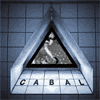 What is the difference between Cartertutti‘s first album, and Chis Carter and Cosey Fanni Tutti‘s previous releases as Chris and Cosey? Well, the main thing is that there is a yet further developed edge to the electronics, the music flowing with a sound which comes perhaps from software more than hardware, though to be sure the cornets, guitar glissandos and occasional harmonica are ever present at key moments in the mix. Cabal presents a development of their sound, one which plunges yet further into the psycholgical undertow with a feeling of abandon, like falling backwards blindfolded onto an unknown absorbent surface and bouncing uncertainly back up into air.
What is the difference between Cartertutti‘s first album, and Chis Carter and Cosey Fanni Tutti‘s previous releases as Chris and Cosey? Well, the main thing is that there is a yet further developed edge to the electronics, the music flowing with a sound which comes perhaps from software more than hardware, though to be sure the cornets, guitar glissandos and occasional harmonica are ever present at key moments in the mix. Cabal presents a development of their sound, one which plunges yet further into the psycholgical undertow with a feeling of abandon, like falling backwards blindfolded onto an unknown absorbent surface and bouncing uncertainly back up into air.
Cabal continues along the mind-expaning pathways Cartertutti have explored since their Throbbing Gristle days, woozy rafts of sound floated on rumbling chords and beatless rhythms, the myriad webs of echo effects as important in (dis)establishing a hypnotized sense being set of out of time. This drift from sensory state to occasional bouts of dub weightlessness, of grounded bass-loop solidity, of waking dreamstates and peripheral audition is characteristic of the duo’s work, and one which finds a refined expression throughout Cabal.
To characterise this album as Ambient is at once over obvious and yet still somewhataccurate; it is chilled, often easy on the ear if not the brain, sounds merge and ripple sensually, caressing the nerve endings and receptors. Cabal could easily pass the floatation tank test of languourous bliss-out, but as ever with an underlying sense of unease, an occasional frisson of dread, which finds itself pushed firmly into the lower recesses of conscious comprehension on Cabal, to no untoward effect. Knowing that the lyrics still deal with the borders of sleep and death, of fear and doubt and both Zen acceptance and flinches of paranoia comes sometimes through listening, or from reading the sleevenotes where the words are indistinct, but also from a disquieting presence in the music and sometimes timestretched vocals – and which often remains unstated explicitly. Cabal is a gentle disturber of the zeitgeist, but one which undoubtedly stirs something into the collective unconsciousness which nags softly like a revelation half-forgotten from moments of waking and/or falling asleep.
-Linus Tossio-
CarterTutti – Feral Vapours Of The Silver Ether
Label: Conspiracy International Format: CD
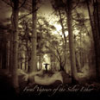 It’s something of a relief to know that, despite the much-trumpeted return of Throbbing Gristle with their recent live shows and this year’s excellent The Endless Not studio album, CarterTutti are not showing any signs of giving up on the day job just yet, as these eleven new tracks prove.
It’s something of a relief to know that, despite the much-trumpeted return of Throbbing Gristle with their recent live shows and this year’s excellent The Endless Not studio album, CarterTutti are not showing any signs of giving up on the day job just yet, as these eleven new tracks prove.
The opener, “So Slow The Knife”, sets out their stall pretty effectively. Beginning with what sounds very much like a collection of sounds which are just pleasant, but have little logical connection to each other, it quickly becomes apparent that it’s all part of a whole – once Chris Carter‘s pulsing bassline comes onboard, everything makes sense. And the echoed cornet sound of yore is still present. There was always something about its use on TG tracks that made me think of wounded beasts calling mournfully to one another across ice floes, and that’s still no less true, though there’s something a lot more beautiful about the sound the way CarterTutti utilise it these days. Appropriately enough, I suppose, given that the ice floes are melting, these days they seem to imbue it with a lot more warmth.
That’s probably the key to this album- it’s the interplay of coolness and warmth – not quite ice and fire, but something a little less extreme. Eno‘s probably a good reference point here, especially when listening to a track like “Torn Window”. But whereas Eno, beautiful though his music can be, often tends to leave one with the lingering impression that there was no real human input into the music, that Brian was just the guy who invented robots to synthesise emotion and watched them all go a bit crazy, here the human heart is very much in evidence. The icy-cool electronica never quite has the self-assurance of an Eno, or even a Sakamoto, but instead reveals a frailty that is all too human at its centre, and is made all the more lovely for that. This is never more apparent than when Cosey is singing, especially on the standout track “Woven Clouds”, which seems to straddle the lines between Eno, Coil (the obvious reference point I was trying to avoid using, but appear to have failed) and, strangely, some of David Sylvian‘s instrumental stuff. By which I mean, really, it’s rather good. By the time you get to “Forest Floor”, and start imagining Gavin Bryars is drifting through space with the lot of them, you’ve realised this is actually a killer album. Then we get the trademark Carter chugging machine pulse coming through on “Acid Tongue”, and, almost mirroring the way the first track began, the disparate elements of the album as a whole all start to make sense together. It’s a pretty neat trick.
If you’ve been put off CarterTutti (or indeed Chris & Cosey) by their seeming glaciality before, then certainly give this a go as they’ve definitely thawed. And if, having any sense, you thought they were great anyway, then DEFINITELY give this a go, as it would appear they’ve put the heating up a little.
-Deuteronemu 90210-
DJ Cartman – Disco Pulpo
Label: Grow! Format: 12″
Well, what can I say? If I watched more South Park, DJ Cartman‘s name might have induced some sympathy. I always seem to miss South Park though, so I guess the sympathy flies out of the window. No, no, no, this just reminds me of Ibiza House too much. OK, thats a little harsh. There’s not much signs of the dreaded Handbag here, but to be honest this record still doesn`t do much for me.
-N. Sequiter-
Johnny Cash – American III: Solitary Man
– Label: American Recordings/Columbia Format: CD,LP
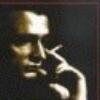 What can I say,what should I say….genius? The Man in Black has really done it again. This recording is timeless and truly brilliant. Its based on a stripped down paradigm like the first American Recordings, even though it is slightly more orchestrated. Its not as consistent as the first Rick Rubin-produced offering, but it has more peaks of excellence.
What can I say,what should I say….genius? The Man in Black has really done it again. This recording is timeless and truly brilliant. Its based on a stripped down paradigm like the first American Recordings, even though it is slightly more orchestrated. Its not as consistent as the first Rick Rubin-produced offering, but it has more peaks of excellence.
The first master stroke is a duet with Will Oldham, transmuting Will’s “I See A Darkness” from a great song to a epiphany of pain and love. Another wonderful interpretation is of Nick Cave‘s “The Mercy Seat”, which climaxes in great cascading waves of grand piano…you just gotta hear it. “Would You Lay With Me In A Field Of Stone?”,is another masterpiece which has this almost eerie sense of intimacy and emotional weight that is so characteristic of Johnny Cash. The climax of the record is the traditional “Wayfaring Stranger” which uses fiddle and harmonium in a really powerful way. It has a clear quality of moon-drenched nights of yearning for release, of redemptive final realisation. It just doesn’t get better than this.
Having said that we must reflect upon the fact that Cash has been playing for half a century and still comes out with something like this in the year 2000. I personally think the work he has done with Rubin is his best. All that experience, depth and wisdom just shines through his voice. It is something that has to be experienced.
-Dag Luterek-
Patric Catani – Attitude PC8 (AKA Hitler 2000)
Label: Digital Hard Core Format: CD (2LP)
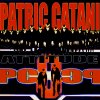 New DHR shit! New DHR shit! You should all know by now what that means – enough fucking decibels contained within a little silver disc to bring down any number of thousand-year Reichs, and look damn sexy while they`re about it! And boy, in this year when defacing a statue of Churchill (a man who, incidentally, saw the use of mustard gas on the Kurds as completely reasonable on the grounds that they were a barbaric and uncivilized people- hmmm. Sound familiar to anyone? No, well, I must just be one of those paranoid fuckers who talk to themselves on the bus) is considered a crime more heinous than shooting a guy in the back with an unlicensed gun (killing him in the process, incidentally) in public opinion, then boy do we need it. This time round it’s Patric C, the closest thing EC8OR have to a George Peppard as Hannibal Smith figure wearing the Ché beret, with this `ere fucker titled Attitude PC8 on CD and, just to keep `em guessing, Hitler 2000 on the vinyl. And whoah, does it Rock. (That was, incidentally, a rehetorical question, meaning I already know the answer, thanks, and that answer is fuck yes!) The vinyl’s title is taken from a Boys From Brazil sample which kicks the whole thing off, before launching into that trademark DHR “all the drums and all the bass but bunged into a box and repeatedly machine-gunned until they`re dead, then, and only then, strapped up with explosives, reanimated, and made to walk into your local Nazi’s house and shit on his pillow before exploding in a righteous blaze of anger” kind of groove.
New DHR shit! New DHR shit! You should all know by now what that means – enough fucking decibels contained within a little silver disc to bring down any number of thousand-year Reichs, and look damn sexy while they`re about it! And boy, in this year when defacing a statue of Churchill (a man who, incidentally, saw the use of mustard gas on the Kurds as completely reasonable on the grounds that they were a barbaric and uncivilized people- hmmm. Sound familiar to anyone? No, well, I must just be one of those paranoid fuckers who talk to themselves on the bus) is considered a crime more heinous than shooting a guy in the back with an unlicensed gun (killing him in the process, incidentally) in public opinion, then boy do we need it. This time round it’s Patric C, the closest thing EC8OR have to a George Peppard as Hannibal Smith figure wearing the Ché beret, with this `ere fucker titled Attitude PC8 on CD and, just to keep `em guessing, Hitler 2000 on the vinyl. And whoah, does it Rock. (That was, incidentally, a rehetorical question, meaning I already know the answer, thanks, and that answer is fuck yes!) The vinyl’s title is taken from a Boys From Brazil sample which kicks the whole thing off, before launching into that trademark DHR “all the drums and all the bass but bunged into a box and repeatedly machine-gunned until they`re dead, then, and only then, strapped up with explosives, reanimated, and made to walk into your local Nazi’s house and shit on his pillow before exploding in a righteous blaze of anger” kind of groove.
There is, of course, some respite, although I use the word in its broadest sense.”Comonomyhouse” isn`t as loud, but it’s very sinister and keeps sounding like it’s either going to burst out into sonic chaos or Steven Stapleton‘s gonna turn up and perform brain surgery on you. Yes, it’s that good. Restraint? Yeah, Catani can do that too, as long as you let ‘im use lots of spooky sounds and cool echoey effects, and even if you don’t, he will anyway. So fuck you. Then you`ve got “Cows”, the most innocuously-titled piece of music since Ghostface Killah‘s “Fish”. Only this is better, a kind of hard-beat distortathon with distinctly dodgy undertones which I can’t really describe. Buy it. Now. Elsewhere, there`s “Vectracks”, which is just way cool, like a cross between Bomb 20‘s glorious “Made Of Shit” and the occasionally-brilliant Aphex Twin‘s moment of occasional brilliance that was “Ventolin”. Alternatively, think Alec Empire‘s Nintendo Teenage Robots if he’d not been quite such a purist and let himself use some effects. I liked it (We Punk Einheit), by the way. You’d probably hate it, but then, you’re probably a twat.
Back to the hard beat (God, don’cha just love that people are doing that again, albeit discreetly? I mean, just look at the Primals these days!), “Risky Sexual Practice” sounds like Front 242 were giving a party and some dodgy House pianist from the early Nineties popped round, only to get spiked with Ketamine and shagged by a herd of robowildebeest (yes, I firmly believe there are such things- they were invented by Buzz Aldrin and Neil Armstrong and are the reason why the moon landings were faked. They needed an alibi, y`see – “Creating rapacious new cybernetic organisms? Not me, guv. On the fuckin` moon, weren`t I?”)
 The whole thing is topped off with “Don`t Try Blowin` Smoke Up My Ass”, which manages to do all of the above at once, and the title of which, according to an American friend (note I said “AN American friend”, not The American Friend, `cos that’s a movie with Dennis Hopper in it, and I don`t know it personally so probably wouldn’t follow its advice) actually means “don`t bullshit me” whereas I was, up until then, taking it literally and thinking “okay, I won’t then; I’m sure I can manage that” which sounds ace and then ends abruptly. Oh, and all you closet fascists who like DHR stuff out there, if there are any such freaks, buy this, ‘cos all yr cash goes straight to anti-Nazi campaigns too. Then fuck off.
The whole thing is topped off with “Don`t Try Blowin` Smoke Up My Ass”, which manages to do all of the above at once, and the title of which, according to an American friend (note I said “AN American friend”, not The American Friend, `cos that’s a movie with Dennis Hopper in it, and I don`t know it personally so probably wouldn’t follow its advice) actually means “don`t bullshit me” whereas I was, up until then, taking it literally and thinking “okay, I won’t then; I’m sure I can manage that” which sounds ace and then ends abruptly. Oh, and all you closet fascists who like DHR stuff out there, if there are any such freaks, buy this, ‘cos all yr cash goes straight to anti-Nazi campaigns too. Then fuck off.
-Deuteronemu 90210, self-styled so-called anarchist, for thirty quid and a packed lunch-
Patric Catani – 100 DPS
Label: DHR Format: CD,12″
Hardcore, hardcore and more hardcore from one of the (extremely hardcore) Ec8or crew. From the opening blast of “My Shame” onwards, Patric Catani deploys shuddering bass loops, filtered cacophony and protesting machine noise extracted from technology under duress, demonstrated perfectly by the evocatively-titled sludge monster “Flesh Dissolves In The Acid Of Light”. What’s more, as this is part of DHR‘s Limited Series, he gets to mess around outside the structured album release, and is also much longer than a single at 45 minutes on CD.
For all the clattery breakbeats and thundering drum sounds, there’s a touching, squittering sweetness to nauseous tracks like “Radio Stations Inside My Head” or “Operape,” as the sound of the ether and the faint tracks of surface glitches get pummelled by the devious, relentless noise assault. Queasiness seems to be the order of the day, as with the lunch-regurgitating break and distorted “Fuck you’s” and transfigued melodic snippets of “You Hate Me, I Hate You,” leavened with a cathartic dose of explosive mechanoid aggression. Each moment of relative calm prefigures another battering, and Catani works the balance between total noise-out and adrenal rush with skill, slipping in a revivalist chant or demonic sermon as the mood sees fit. Cataclysmic, throbbing and perfect for subduing neighbours who think that booming swingbeat is the way to enliven a party.
-Freq1C –
Cativo – Jack Knife Power Bomb
Label: Position Chrome Format: 12″
Cativo is apparently chums with Panacea, and has been known to DJ at airports – which sounds like a good idea, and no doubt showed Brian Eno a thing or two about the kind of sounds appropriate to places usually filled with paranoid security warnings about leaving possessions unattended with consequent danger of Bomb Squad demolition, hardcase customs officialdom and confused travellers in search of their luggage. “Jack Knife Power Bomb” starts off all melodic, and then brings in the elements of harshness which make for a righteously kicking Drum & Bass stormer. Franticly rewound beats, synths readying for takeoff, snares propelling everything into warp-speed and space-shot vocal samples – and then the bass-drops and whirling blades of timestretched treble make all complete in a most expansive manner.
“Another Vision” has decidedly more wobble to it; opening with a gut-churning selection of attenuated bleeps and swirls, Cativo is intent on taking things into unsettling areas, sneaking tearing bass squalls up from behind and bringing the rhythmic elements in from the side until they all meet in a pre-arranged consolidation of the sound spectrum. Shivery (former) string samples and half-identifiable vocal shimmers make for good accompaniment to the rapidly accelerating kicks and breaks; the orgasmic moans aren’t even out of place for a change, as there’s quite a sensual element to this track which makes perfect sense, especially as the prolongued pounding recedes into fragmentary trails of residual, clinging cymbal-snippets.
-Freq1C-
Monte Cazzaza – Power Vs. Wisdom, Live
Label: Side Effects Format: CD
A recording from All Hallow’s Eve, 1991, on KPFA in San Francisco. Chains and hooting, drums, crowing. A witches’ speech from Shakespeare is played – bubblebubblebubbletoilandtrouble and all that. Eye of newt, et cetera. Much incantation. Mark of the devil – Mark of the devil! From the trailer to the film of the same name. “The rack…the claw…the tongs! Devices that made death a welcome pleasure! Every torture device authentic – actually used at one time!” There is a certain theatricality and showmanship that has been missing from experimental music, in several corners.
“Where is the love to be found?” And with showmanship comes sentiment – which is not necessarily a bad thing – especially concerning six eyes from hell. Following this is the answer to the question “What is death?”. Invaluable information – another hallmark that has ceased in release, to a great degree. The inserts and leaflets accompanying such early recordings – where are they now? And putrefaction begins. A treatise on psychotechnology follows. Synthetic sounds smoke the background, wafting hither and that, never overwhelming the provocation of thought from words transmitted. Melody over a feminist chant. And the womb is a happening place, you fucking stud! “Don’t believe in witches? You’d better believe in the Virgin Witch – she’ll blow your mind!”
The strange thing is that we speak so seldom to each other about this often-lonely business of experimental music – but recognition of these sound samplings = well, we must have some kind of common ground! Some final comments about the performance, and then two tracks from 1980 in England. As with any historical document, the impact – the direct impression – is difficult to gauge in the dark light of day. To-day, at least. Leeds Ripper Song. First/Last. At last.
-David Cotner-
Ccru – Nomo
Label: Syzygy Format: CD
Created for the Syzygy project at The Beaconsfield in South London in Spring 1999, Nomo shows all the signs of having been created under the influence of one of the more amous semi-legendary creations of this century, none other than Great Cthulhu himself. Opening with a cod-prayer to Nomo, the CD proceeds to delve into the watery abyss with a soundscape of creaks, drips and murmured vocal fragments, conjouring the fog-bound reaches of a Lovecraftian marine horror story. The injection of suitably ominous samples on the subject of sub-aqua, subterranean dwellers in darkness adds to the atmosphere in an effectively spooky manner.
Dreamlike washes of sound, layered booms and attenuated descriptions of lurking horrors abound in the run up to the materialisation of a pulsing electronic beat which develops some tumbling breakbeats among the recursive echoes – it’s rather as if some of the moody collages of NoN or The Hafler Trio had been remixed; which can only be a good thing. When the boom-box Dub clatter kicks in properly, the effect is darker than most Drum & Bass, which is still geared towards the dancefloor in some manner – this is more concerned with the primal aquatic threat of immersion in various forms, even bringing in the Millenium and its discontents along the way.
There seems to be some relation between this project and notions of the Black Atlantic, the history of the middle passage and the African Diaspora, linked in with aspects of the Capitalist system as a all-devouring, lurking manifestation of Cthulhoid monstrosity, demanding sacrifice in the water to feed its own desires. Whatever the intentions, the results are quite effective in their murky evocation of gloom and (even) doom, in the sense of fate, and the resulting interplay of darkling shadows as represented by the babel of disembodied voices, gurgling wet sounds and abstracted trails with the organised rhythms of the beat which keep the primal Chaos at bay – while never quite disentagling itself from the fascinating pull of the unheimlich.
Contact Katasonix for ordering details.
-Freq1C-
James Chance And The Contortions – White Cannibal
Label: ROIR Format: CD
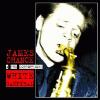 In the late Seventies and early Eighties there was The Pop Group to brink the Funk to Punk in Britian; but in New York the beandleader of the Wave alongside No which brought Jazz and other grooves into the wake of three-chord noise and upfront attitude was Mr James Chance and his backing band, the rather special Contortions. For this collection, originally released on cassette as Live In New York in 1981, the group consist of members of Ornette Coleman‘s ensemble and Defunkt – not forgetting the Discolitas on backing vocals.
In the late Seventies and early Eighties there was The Pop Group to brink the Funk to Punk in Britian; but in New York the beandleader of the Wave alongside No which brought Jazz and other grooves into the wake of three-chord noise and upfront attitude was Mr James Chance and his backing band, the rather special Contortions. For this collection, originally released on cassette as Live In New York in 1981, the group consist of members of Ornette Coleman‘s ensemble and Defunkt – not forgetting the Discolitas on backing vocals.
Overall, the quality of these recordings captures what must have been a fearsome live experience. This fire doesn’t so much as express itself in the noisiness or intricacies of the playing (though there is some of the former and plenty of the latter) as through the whole created under the raggedly soulful vocals of James Chance. Above all, the essential feel of a live show is conveyed – this is not a selection of studio recordings captured faithfully on stage, but a full-on, in the room sound which takes on the qualities of documentary and time(less) machine as appropriate.
What’s even better is the group’s take on “I Feel Good” and “That Old Black Magic” – standards made fresh in the rawness of the sound itself, and the distinctly anarchic interpretations. Where Funk had sometimes got itself locked into a commercial groove at this time, here the emphasis is on pushing the boundaries while keeping the feel and rhythms one the one at all times. When a track stops, the need for more is suddenly apparent – a mark of quality if ever there was one – and the moodswings from slow honking sax and drifting drums of the slowburning version of “King Heroin” can whirl off into the swinging groove of the title track with distracting, hypnotic ease. So much so, that when things really start to take off for “Money To Burn” and the explosive “Contort Yourself”, the slip into high gear and the controlled chaos of the brass section (including some quite outrageously, but perfect, interjected trombone bellows from Joe Bowie) makes for a satisfyingly energetic conclusion.
-Antron S. Meister-
Changes – Legends
Label: Taproot Productions Format: CD
The acoustic guitar streams forth stories of those olden days. Is the heritage of centuries ago transmitted through certain lineages? Can memory be perfectly preserved from generation to generation? Are folk memories a trait that contributes to the survival of the fittest? “Calling forth for us to go…” The end of the recording makes the CD player emit and sad and hollow sound…finis.
-David Cotner-
Sylvain Chauveau – Un Autre Decembre
Label: Fat Cat Format: CD
Chauveau‘s solo piano compositions featured here bear a superficial resemblance to some of Satie‘s work. Limpid chords hover then slowly disappear leaving their impressions like faint tracings of light in a darkening room. But there is more to this short recording. Along side the uncluttered piano he uses samples and little shreds of electronic noise and field recordings. For example on “Neuf Cents Lunes” there is surface crackle and other small sonic distractions to edge the music away from the soporific.
On the four short “Granulation” pieces there is a range of electronic sampling with some snatches of voice but the piano is absent. Further samples are introduced into the keyboard meditations on “Il Fait Nuit Noire A Berlin” and “La Lettre Qu’il N’Envoya Jamais”. By way of complete contrast the final track is given over to the equally unadorned accordion of Vincent Pouplard which is redolent of early twilight in a small French town.
The overall effect of these pieces is quite melancholy but still attractive and at just over 23 minutes I felt I would have liked some more.
-Paul Donnelly-
Chicks On Speed – …Will Save Us All
Label: Chicks On Speed Format: CD
 Chicks On Speed, at first sight, promise to be one of those bands who, like DIY products, can claim to do exactly what it says on the tin – hands up who expected a Lolita Storm-style feminist Digital Hardcore kind of sound? Well, maybe just me, then. Opening with a fake ad a la Negativland, COS launch out into a plethora (does 13 count as a plethora? Well it fucking does now) of eclectic songs and styles, ranging from the noisy (“For All The Boys In The World”) to the slightly scary (“Kaltes Klares Wasser”) to the… well… just downright fucking (knowingly) cheesy (“Glamour Girl”, take a bow!). On the way we meet Sheep On Drugs (remember them? Chicks On Speed seem to…), The B52s (yes, those B52s, whose “Give Me Back My Man” never sounded quite so fucking warped as it does here), and the ghost of Sigue Sigue Sputnik (yes, yes, I know, but it’s all so much better than I’m making it sound).
Chicks On Speed, at first sight, promise to be one of those bands who, like DIY products, can claim to do exactly what it says on the tin – hands up who expected a Lolita Storm-style feminist Digital Hardcore kind of sound? Well, maybe just me, then. Opening with a fake ad a la Negativland, COS launch out into a plethora (does 13 count as a plethora? Well it fucking does now) of eclectic songs and styles, ranging from the noisy (“For All The Boys In The World”) to the slightly scary (“Kaltes Klares Wasser”) to the… well… just downright fucking (knowingly) cheesy (“Glamour Girl”, take a bow!). On the way we meet Sheep On Drugs (remember them? Chicks On Speed seem to…), The B52s (yes, those B52s, whose “Give Me Back My Man” never sounded quite so fucking warped as it does here), and the ghost of Sigue Sigue Sputnik (yes, yes, I know, but it’s all so much better than I’m making it sound).
Taking no shit while still making taking no shit sound fun and bouncy, this is an album with something to confound everyone. Whether fucking around with The Normals “Warm Leatherette” or pretending to get all cutey and girly on “Little Star” before informing us that “The Pope he says you really smell”, Chicks On Speed (whose press release takes pains to point out that these Chicks aren’t literally On Speed- at least not all the time, which is good, `cos if I want an hour of insane sincerity about various bollocks and an inordinate amount of licking one’s own lips then I know people to hang out with already, OK?) seem to delight in the wilfully perverse- the aforementioned “Glamour Girl” leaving no stone unturned in its quest to out- Waterman Pete, whereas tracks like “Mind Your Own Business” and “The Floating Pyramid Over Frankfurt That The Taxi Driver Saw When He Was Landing” seem content to kick around the legacy of DAF, but bunging in the surprise substitution of a sense of humour, barely beating the kitsch element in a hard-fought match…
OK, enough of the football analogies – apart from anything else, I can neither stand, nor understand, anything about the fucking game. Why watch sports when you can stay in and listen to Chicks On Speed? The future of post-post-post-feminism starts here.
-Deuteronemu 90210 On Booze & Cough Syrup-
Chicks On Speed/Kreidler – The Chicks On Speed/Kreidler Sessions
Label: Chicks On Speed Format: 12″,CDS
The teaming up of Chicks On Speed and Kreidler has brought two intriguing groups into proximity with mixed results. The conversational, storytelling style of the three Chicks On Speed works rather well with Kreidler’s somewhat quirky Eighties-influenced electronic brightness, and both groups blend their respective eccentricities together neatly. “Sliding Down Your Ribcage” offers a dose of sexuality more erotic than sleazy on an unfolding laid-back stream of consciousness, both “La la la” lyrically and musically, as the tune wrings further lateral effect from the groove.
There are the twinklings and staccato blips of “Frequent Flyer Lounge Song”, offset with lurching bass and “do do do-doo” vocals and arch observations on dancing, which comes closest to being a floor-friendly Pop song when the refrain of “Dance/music” is repeated to a progressively more Funked-up bleepathon. Oddest of all is the hissing and crackling interpretation of Nick Cave and Kylie Minogue‘s “Where The Wild Roses Grow”, with the vocal parts sung by all parties (with male and female voices switched) quietly through a distant distortion to an increasingly dissolute backdrop of muted chords and dribbly glitches. As a bonus, the CD single also contains a short video of the participants hanging out in the studio together while working on the tracks.
-Antron S. Meister-
Wild Billy Childish And The Buff Medways – Medway Wheelers
Label: Damaged Goods Format: CD,LP
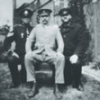 After the previous two releases by Wild Billy Childish and the Buff Medways I was starting to form the opinion that the Buffs are one of those bands where, like Mötörhead, every album is basically the same. Indeed, I remember buying a new Mötörhead album as a teenager and reading through the track listing managed to predict accurately what each track would sound like. And this impression was in no way diminished in Billy C’s comment about the last Buffs album, 1914, where he suggested that there was absolutely no progression from its predecessor, Steady the Buffs. And, in spite of the fact that 1914 is a fantastic album, he was perfectly right. However the Buffs’ latest offering, Medway Wheelers, is different, is a progression and is also a fantastic album.
After the previous two releases by Wild Billy Childish and the Buff Medways I was starting to form the opinion that the Buffs are one of those bands where, like Mötörhead, every album is basically the same. Indeed, I remember buying a new Mötörhead album as a teenager and reading through the track listing managed to predict accurately what each track would sound like. And this impression was in no way diminished in Billy C’s comment about the last Buffs album, 1914, where he suggested that there was absolutely no progression from its predecessor, Steady the Buffs. And, in spite of the fact that 1914 is a fantastic album, he was perfectly right. However the Buffs’ latest offering, Medway Wheelers, is different, is a progression and is also a fantastic album.
The current incarnation of The Buff Medways, retaining Wolf Howard on drums and yr man Childish on guitar and vocals, has been augmented by Graham Day, of the seminal Medway beat group The Prisoners, replacing Johnny Barker on bass and vocals. The group dynamic remains that of a tight Garage power trio – even something of a Medway supergroup what with Howard from The Prime Movers and James Taylor Quartet and Childish’s key role in just about any Chatham based garage band you care to name. Day’s backing vocals move the Buffs a few degrees in the direction of the 60s revivalism of his previous band, but the Buffs remain something of a punk reinterpretation of The Who.
The new direction is not immediately apparent as we put the album on first time: “The Man I Am” strongly resembles “Troubled Mind”, the opener from Steady The Buffs, but with Blues harp wailing from Jim Riley and a simplified chorus groove. But it’s the chorus, where Graham Day’s vocal backing open up the harmonic structure of the track, that hints at the changes to come. This is one of those Billy C tracks where the poet once more eulogises the enormous chip on his shoulder – a chip which just grows and grows. In the next track, “A Distant Figure of Jon”, the chip is back, this time saturated with insecurities emanating from a father-figure: mentor, super-ego, godhead – “A person who I can’t see who is the boss of me.” Musically here we’re firmly into 60s Pop-rock, scuzzed up by guitar and bass mashed by lo-fi Vox PA and Wolf Howard’s full-on drum assault.
In the next track, “Karen With a C”, not lyrically one of the more interesting pieces of the album, the drumming is again fantastic: powerful, acrobatic, aggressive – it’s hard to underestimate the importance of Howard’s backbeat. But in “22 Weeks” we are back into the fluent Childish narrative voice. A crap job and its ensuing fallout thirty years ago still bug our hero. Some might say, “get over it, Childish!” But where the poet can transform these unresolved memories into such sublimely catchy Garage Rock, this reviewer is rather glad that he hasn’t. And it’s this lived-in experience that lifts Childish head and shoulders above a hundred young Turks scrabbling for his Garage crown. The anger, bitterness and wit are never simply a posture – perhaps in places this “write what you know” formula feels somewhat laboured, but it’s in the tracks where the specificness shines out that this album takes on the mantle of greatness.
After a Link Wray-ish instrumental, “Dustbin Mod”, one of the finest examples of this specificness comes out. The album title track turns his mother’s stories of a cycling club in the mid-Forties into a unique Garage-pop anthem. It’s an unlikely subject for a Rock’n’Roll number – you just don’t talk about your mum in Punk Rock, unless you’re complaining that she stops you from going out late at night. Particularly effective is the build-up of tension in the last verse – “they thought they’d never get there” and accounts of cycling accidents in traffic, followed by the triumphant final chorus. But this track is covered in more detail in another review on this site, so we’ll move along through the album. “Lie Detector”, like “Karen With a C” is a far more typical Punk Rock stomp – perfectly effective but lacking in that spark of the next track, “Private View”, in which the chip on Childish’s shoulder takes on the art establishment. Here again where the poet takes on a subject that he feels strongly about the wit and anger shines. However the track which follows, “The Poets Dream”, is for this reviewer the best track on this album. Musically it resembles one of those delicate 60s Flower Power pop songs, something like The Lefte Bank‘s “Pretty Ballerina”. There’s a definite chiming twang to the guitar line and the middle section feels like it could easily use a sitar break. And the Eastern promise doesn’t stop there: the description of the lover “she brings jewels and flowers, she smiles and devours” simultaneously puts us in mind of Kali, the destructive aspect of the Hindu goddess, as well as the dark woman of the Song of Solomon. Quite a different love song from “Nurse Julie” on the 1914 album.
“You’re Out The Band Sunshine” is a particularly meaty number in which Graham Day’s farty bass gives it some oompah. It’s another incident from the Billy C archives, perhaps a love tangle in the days of Punk and The Pop Rivets, back when he’d “bought this guitar I couldn’t afford and wrote twelve songs with three chords”. It romps along at a fair pace, but it’s followed by the angular “Poundland Poets” with an effective chug resembling The Fall at their most agreeable, celebrating tatty Chatham Poundland chavvy rubbish, but also accepting it as part of their Medway heritage, with an art-rockiness not unlike “We Are All Phonies” on 1914.
So after having dealt with all of the Billy Childish staples: art, family, history, anger, alientation, poetry and transcendence, The Buffs leave us back in the playground with a final chug through The Who riff directory. “I’m Glad I’m Not Like David Wise” recalls the struggles of the unpopular kid and his wealthy tormentor. The chip on the shoulder is back, but when we imagine what David Wise might be doing today: he’s certainly not an internationally recognised painter, poet and Punk Rock prophet. For a lesser artist looking backwards in this way would be fatal and frankly slightly pathetic, but it works for Childish, and the proof of the pudding is in this album, which holds together coherently both as a recording of one of the key garage bands of the moment as well as a jewel in the Wild Billy Childish backcatalogue.
-Iotar-
Label: Pigdog Format: CD
Splattercore HipHop noise terror in the Ambush or DHR stylee, Cho’pin delivers the beats in great big wadges of bassy distortion with a leavening of scuzzy effects to make the speakers groan in protest. With a predeliction for Skiffy bleeps and regurgitative trills left to make tracks for their own sake, and the ever-ominous boom box lurking on the horizon, Minkus is quite good at irritating ears and threatening the stability of windows.
Take “My Brother The Robot” as an example track – it has a buzzing robo-vocoder vocal loop which drives itself into brain-splitting repetition, some grinding noise to set the teeth on edge, and also knows how long of that is just about enough for listening comfort. And in between the rewound swathes of scratchy scum, there’s time for some lethargically downbeat HipHop loops with piano and guitar accompaniment of “In The Body Without Organs (Suite)” – a Deleuze & Guattari-referencing trio of modal reflectivity, or the distrait pitch-shift sample setup “My Brother The Drug Addict”.
Still, the main emphasis here is on noisy, heads-down chugging and swirls of flanger fallout which reaches some splendid levels of anti-Funk on pieces like the short slouch of “Too Cool, Too Dance, To Dance” or the churning paranoiac sludge which is “Act Mad”. There’s headfirst Drill & Bass mania too in “Attack Of The Cho’pin Children,” and it all shuts down with “Arose”, a 22-minute welter of dolorous noise. Even considering the ear-bending effects of the latter, Minkus shows abmirable restraint and variety in its (ab>use of the dynamic properties of music machines under pressure.
-Freq1C-
Chris And Cosey – The Essential Chris And Cosey Collection
Label: Conspiracy International Format: 2CD
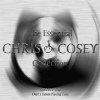 The title really does say it all – this is a collection of 31 Chris And Cosey tracks from twenty years of releases, and they pretty much are essential for anyone who wants to know what the duo sound like. From the rrrrolling percussive swoon of “Exotika” to the preacher-sampling post-Throbbing Gristle thump and reverb of “Put Yourself In Los Angeles”, the compilation takes a trip (or two) through C&C’s highly influential take on Electro, Techno and Electronica, bringing 12″ rarities “Obsession” and “Synaesthesia” to CD among old favourites such as the haunting “One Minute More” and the ominous dub harmonics of “Raining Tears Of Blood”.
The title really does say it all – this is a collection of 31 Chris And Cosey tracks from twenty years of releases, and they pretty much are essential for anyone who wants to know what the duo sound like. From the rrrrolling percussive swoon of “Exotika” to the preacher-sampling post-Throbbing Gristle thump and reverb of “Put Yourself In Los Angeles”, the compilation takes a trip (or two) through C&C’s highly influential take on Electro, Techno and Electronica, bringing 12″ rarities “Obsession” and “Synaesthesia” to CD among old favourites such as the haunting “One Minute More” and the ominous dub harmonics of “Raining Tears Of Blood”.
While a track like “Obsession” sounds decidedly dated on one level, there’s an air to Chirs And Cosey’s work which takes it into darker and more dangerous areas than most of their contemporaries. Cosey’s lyrics, warm with firm sexuality and more than a hint of polymorphous perversity at one moment, icily desparaging (as on “Dancing On Your Grave”) the next, uncoil a complex of human emotions and states of mind at the more extreme ranges of experience. Their music invokes trance states, otherworldy dreams of love and lust, built with clinical precision to extend and promote the hallucinatory rhythmic properties of deepy-involved dancing. Using early (now vintage of course) analogue and digital equipment to the full, they often pulled and tweaked new forms into being among the voluminous dross which largely characterized Eighties electronic Pop music. The Nineties selection has a different feel again, wavering from doomy atmospherics to subtly-inflected Trance-heavy drum machine stomps wafted through with a fog of shimmering effects and the ever-sensual voice of Cosey Fanni Tutti.
Taken on their own merits, many of the swinging beatbox classics like “Blue Velvet”, “Vengeance” or the passionate slow dance chorale “Dr John” retain an eerie dancefloor charm, redolent of smoke and black drinks in underground strobe-filled chambers – and no, it never really did die or go away. Now that the Eighties and early Nineties are undergoing some sort of revival and reappraisal, it’s a fitting time to bring out the contribution that Chris And Cosey made out from the underground again.
-Freq1C-
Chris & Cosey – Exotika and Take Five
Label: CTI Format: 2CD
With some kind of Old School Electro revivial finally being promoted at mass-cultural level, with vocoders and strangely archaic afros back in fashion (after all, they never did really go away – the vocoders, at least), it’s only just and right that Chris Carter and Cosey Fanni Tutti should remaster (including subtly different mixes of some tracks) and re-release two albums which helped shape the underground electronic music of the Eighties which has now filtered into the wider musical consciousness.
Chris and Cosey often declared their desire to be a pop phenomenon along the lines of Abba in their Throbbing Gristle days, but the mid-Eighties was never really ready for them on that level. What sets this material apart from most of that decade’s electronic body music is the warmth of the production, though thirteen years of Acid House to Electronica have by turns embraced, discarded and rediscovered some of the more kitsch elements such as the wobbling bass, reversed hits and programmed drum rolls found on tracks like “Vengeance” or “Relay” or the echoing anthemic vocals of “Dancing On Your Grave”. Take the title track on Exotica – a swirling, rolling machine beat of considerable warmth underpins a suitably lush vocal line of few words and much sensuality – which was a bit of a House and Goa Trance hit and incidentally shares a similar mood to the early works of much-overlooked Japanese artist Phew. Similarly, October (Love Song) from Take Five reverberates with the almost atavistic synthetic drums and chiming keyboards of its time, and for this collection the two tracks have been megamixed in Nineties hard-disc style into “Exoctoba”, while the obligatory extra unreleased track “Gofex” is a jaunty melange of four-square beat and upbeat tinkling offset by sampled screams of joy or agony.
As with the other formations which followed the demise of TG, Chris & Cosey had an outsider perspective which undercut the simply hedonistic element of electronic Trance music; where Coil explored the scatalogical and alchemical possibilities, or Psychic TV concentrated on the magickally ecstatic (to generalise wildly), C&C combined similar approaches with their chosen path of decadent rhythmic sensuality. Even in the most dated sounding tracks like “Smell The Roses” have a subtle ennui among their chiming keyboards and near-slap bass, while “Love Cuts” stands out as a menacing blend of post-Moroder groove and sinister, minor-key machinations backing up Cosey’s disarmingly dangerous vocals, and “Send The Magick Down” is a suitably-Crowleyian comedown piece. For all the vagaries of fashionability, Exotica and Take Five possess sufficient timeless elements to justify their re-appearance, showing that it wasn’t all spangles and glow-sticks on the dancefloor in the Eighties as the post-Industrial movement from noise into groove brought along the uncanny and the unsettling for the trip into the all-embracing phenomenon of electronic dance music.
-Antron S. Meister-
Chris & Cosey – Union
Label: CTI Format: CD
 Union is a record of Chris & Cosey‘s stunning return to live performance at The Union chapel in London earlier this year as part of Labradford‘s Second Annual Festival of Drifting, and reveals a quite breathtaking range of subtleties from the concert which deserve closer attention away from the awesome spectacle of the event itself. Having said that, the acoustic space of the Chapel makes its presence felt throughout, and the nuances of echo and reverberation make for a special auditory experience quite above and beyond the mere usefulness of having a CD to revisit the spirit of the occasion itself.
Union is a record of Chris & Cosey‘s stunning return to live performance at The Union chapel in London earlier this year as part of Labradford‘s Second Annual Festival of Drifting, and reveals a quite breathtaking range of subtleties from the concert which deserve closer attention away from the awesome spectacle of the event itself. Having said that, the acoustic space of the Chapel makes its presence felt throughout, and the nuances of echo and reverberation make for a special auditory experience quite above and beyond the mere usefulness of having a CD to revisit the spirit of the occasion itself.
Emerging from a coruscating realm of fluttering electronic treble and wall-washing bass come the acheing bows of stroked guitar strings in sonorous wells of stretched, coiled sound; the mood is decidedly reverent at first, slipping sacramental vocal calls and whispers into the keyboard chords which provide some kind of modern counterpoint to the (unforunately) silent pipe-organ of the venue. The gradual emergence of tranced-in pulses, arpeggiations and the chugging spread of sometimes darkly brittle oscillations of “Subondare” sets the pace towards a contemplative hypnagogic state – and the intruding chimes of virtual bells makes perfect sense as a whirl of ominous sound appears and recedes in the sublimely full throb of digital half-beats, propelling the set towards the scathing jig-stomp of “Dancing On Your Grave” which marks the show and album’s (almost abrupt, given the enveloping, apparently endless, meld of sounds) climax.
Cosey’s voice remains as deadpan as ever, describing the more unsettling aspects of inhumanity or chorybantic ecstasy with a detached, clinal viewpoint which makes it only more disturbing – and when “Dr. John” emerges it’s from the swampiest of fogs, the most chilled of glooms. Union conveys the atmosphere of the concert quite superbly; Christ Carter’s spine-tingling keyboard trills and ever-shifting rhythmic undertow (one cycle ethnodubadelic, the next broodingly organic, morphing into Trance Technoid energy coils – and even Industrially Discofied when the C&C classic “Exotika” emerges from the mix), the mid-range snatches of cornet and sideways-scorching guitar from Cosey; the conjoined, liquid flow of elements into a record which really does add so much more to the experience of witnessing the event itself – a rare feat in a live album. Utterly essential listening in its own right, there can be few better examples of the alchemical reaction between performers, space and audience (whose presence can be felt rather than heard) captured on disc than this.
-Freq1C-
Church Of Carbon – Angst
Label: Disko B Format: 12″
 Someone doing up a cover of Bauhaus‘ Goth-Dub extravaganza “Bela Lugosi’s Dead” had better be pretty certain of themselves if they don’t want to get the same pasting as some quarters gave the reworkings of Can on Sacriledge. Fortunately Patrick Pulsuinger and Gerhard Potuznik pay both homage and deconstruct the basics into a splattery Electro feats of analogue synths and darkly steaming beats to satisfy the demands of smoke-filled rooms and velvet-lined tombs everywhere. The doomy vocals of the original are given a sinister, slightly frenzied twist by Potuznik, and the underlying breakbeats are equally gutteral, spasming slightly in a twitchy rhythm ever so suited to the consumption of diet pills and vodka.
Someone doing up a cover of Bauhaus‘ Goth-Dub extravaganza “Bela Lugosi’s Dead” had better be pretty certain of themselves if they don’t want to get the same pasting as some quarters gave the reworkings of Can on Sacriledge. Fortunately Patrick Pulsuinger and Gerhard Potuznik pay both homage and deconstruct the basics into a splattery Electro feats of analogue synths and darkly steaming beats to satisfy the demands of smoke-filled rooms and velvet-lined tombs everywhere. The doomy vocals of the original are given a sinister, slightly frenzied twist by Potuznik, and the underlying breakbeats are equally gutteral, spasming slightly in a twitchy rhythm ever so suited to the consumption of diet pills and vodka.
“New Role” is a tad more lighthearted, with a hugely Eighties tinge to those reedy keyboards, one-finger melody and an echoed Electro main rhythm which trundles along with all the energy of a bunch of wasted New Romantics waving their lacy cuffs in the air just to watch the lasers flicker through to the splayed bursts of analogue synths. That and the progressively decaying vocals gives everything a disturbing resonance of pointy boots and crimped hair. Likewise Red Lorry Yellow Lorry‘s “Shout At The Sky” closes proceedings to a drum-machine chug and the plentiful application of stringy delay and flange effects to the whispered delivery, and of the Moroderizer(TM) to the main melody and rhythm – digital handclaps and all.
-Freq1C-
Circlesquare – Distance After
Label: Output Format: 12″,CDS
 (AHEM!Now let me check my notes…) This, my omnivisceral friends, is an EP of three parts and by jingo, what parts they do be! Let’s be rational for a moment and take them in order. “Distance After”; the title is, unfortunately, rarely, and easily for the reviewer (moi) very appropriate- however, it’s hard to explain why. So I shan’t. Instead I’ll say that this track has lovely washes of sound, nice and crunchy (but vague)percussion – think “Something I CanNever Have” by NIN, but much quieter. I ended up with a large and exotic sea creature – beautiful, yet strangely unaffecting. Imagine you’re at a party, right, and you’re peaking on, like, the best acid ever, but you’re not allowed into any of the rooms and you’re sitting on the landing while someone plays all the good nice bits of Underworld‘s Dubnobasswithmyheadman and you think “that’s quite nice,” but then hear the rest of it from the kitchen ‘cos you’re busy stealing booze…
(AHEM!Now let me check my notes…) This, my omnivisceral friends, is an EP of three parts and by jingo, what parts they do be! Let’s be rational for a moment and take them in order. “Distance After”; the title is, unfortunately, rarely, and easily for the reviewer (moi) very appropriate- however, it’s hard to explain why. So I shan’t. Instead I’ll say that this track has lovely washes of sound, nice and crunchy (but vague)percussion – think “Something I CanNever Have” by NIN, but much quieter. I ended up with a large and exotic sea creature – beautiful, yet strangely unaffecting. Imagine you’re at a party, right, and you’re peaking on, like, the best acid ever, but you’re not allowed into any of the rooms and you’re sitting on the landing while someone plays all the good nice bits of Underworld‘s Dubnobasswithmyheadman and you think “that’s quite nice,” but then hear the rest of it from the kitchen ‘cos you’re busy stealing booze…
“Sub Reminisce”- this is the standout track. There`s a nice Trip-Hoppy beat that keeps pissing you off by fading out then coming back in loud on the on-beat- this is, basically, a track that would have huge financial potential if only it would sell its soul, suck Satan’s cock (cheers, Saint Bill, you will always be remembered) and do what you keep expecting it to- but it doesn’t! Perversely, it stays beautiful, stays lovely, will probably achieve nothing but will sound great while it does it- in a world (my world, it has to be said) where Bill Hicks is Pope, this is the international anthem. Gorgeous.
Now we get weird with a track entitled “Filtering Blue”, and if that don’t make you think of the boy Eno, then… sorry, how did I start this sentence? Sorry, I`m a bit buggered. Let me just go straight to my notes for this track (because it`s, hey man, closer to the subconscious and, fuck it, means I can go to bed that bit sooner) – OK. Here goes.
(Ahem). A really fucked guy in space lying in a gutter playing a space squeezebox while a space orchestra slowly gather (in a spacey kind of way) around him- with a very slow one-spaceman band providing percussion. One-man (space) band may very well have a concealed acoustic guitar- in fact probably does-, but plays along so as not to get the squeezebox bloke arrested. In the meantime, the space orchestra have developed a whole kind of Gavin Bryars thing, despite the beat, and everyone seems to be getting on fine. Again, this is wonderful, but I really don’t know how to sell it to you… how’s about this… BUY ITOR I’LL KILLYOU!
PS. This is an EP full of moments that, if heard at the peak of a monster trip, will haunt you forever. ‘Bye.
-Deuteronemu 90210 in Dinosaur Hell-
(Editorial note: be very careful in the presence of this reviewer… especially at parties.)
Clang Quartet – Jihad
Label: Silber Records Format: CD
 A strange collection of sound collages coming from Scotty Irving, former percussionist of Eugene Chadbourne, Elvis X, and Geezer Lake, among others. Using taped phone conversations, feedback, electronic effects, loops, static, and bits of what sound like Irving lecturing someone or something on music, God, and the spirituality of both – the lectures are especially effective when the voices are jumping from one speaker to another pretty much on every word. The band’s name is a misnomer, by the way – this is a solo project, and not an actual quartet. While I like most of this, mostly because it’s just plain weird, the lecturing bits kind of turn me off because I don’t like to be lectured to, even if it’s not exactly directed at me.
A strange collection of sound collages coming from Scotty Irving, former percussionist of Eugene Chadbourne, Elvis X, and Geezer Lake, among others. Using taped phone conversations, feedback, electronic effects, loops, static, and bits of what sound like Irving lecturing someone or something on music, God, and the spirituality of both – the lectures are especially effective when the voices are jumping from one speaker to another pretty much on every word. The band’s name is a misnomer, by the way – this is a solo project, and not an actual quartet. While I like most of this, mostly because it’s just plain weird, the lecturing bits kind of turn me off because I don’t like to be lectured to, even if it’s not exactly directed at me.
-Holly Day-
Kit Clayton – Nek Sanalet
Label: ~Scape Format: CD
It’s no surprise on first hearing Nek Sanalet that it was chosen to be among the first releases on Stefan Betke‘s new ~Scape imprint; Kit Clayton shares Betke’s interest (as developed in his Pole guise) in the momentous possibilies of analogue synthesis for the production of some bass-heavy grooves. However, the dubscapes Clayton produces are perhaps even more widely spread, taking in some deliquescent vocals among the echoing post-piano sounds and the reverberating frills of keyboad and mixing desk.
There are drum machine chugs and twisted delay controls aplenty though, marking further time in the virtual chambers of reflective, recursive Dub, machine drums and flowing, soothing bass. As the record proceeds, so the definition of percussion and rhytym becomes at once clearer and fuzzier – harder edges on the beats, wobblier on the synths and echo. An increasing urgency beckons attention to the detail of loops and the individual placement of lightly-fried snare in juxtaposition with frazzled melody, all riding on the all-encompassing boom of the undertow. Clayton fully understands and extends the heart and head combination of Dub Reggae – and to deny this music its origins is as futile as ignoring the Rock in its Post- Art- or Prog- flavours – and not forgetting the accretion of 20th Century and much older cultures and technologies which constantly mesh and refract, having found a particular meeting point in Jamaica three decades or more ago; an aspect which Clayton marks in his Native American album and track titles. But enough digression…
What sets such mixing desk manipulations apart is the materials and influences rather than the methods – sequences and samples are slipped on top, across and around each other and the solid heart of the form itself, taking along Ambiences removed several stages from Kingston, JA (heart and substance), via Detroit, MI (bleep and beat) and the basement bass of Brixton (rewind and colliding boom) , Berlin (chill and analysis) or Barcelona (exiled warmth of analogue purity). The onward march of the Dub Outernational, the spreading and evolution of the recombinant viruses of technology and the trip, continues into the timeless future of electronic boby and mind music.
-Freq1C-
Clean – Room 16
Label: SugarShack Format: CDS
This is the debut EP from a Swiss Pop/TripHoppy quintet and it sounds promising. They mix scratchings, edgy drums and samples with straight ahead `Pop’ tunes. Two tracks are `live’ and sound a little more raw edged with drums further up front and the scratching breaking in at various intervals. The press blurb talks about `insanely catchy Pop tunes’. Well, I wouldn’t go that far and I don’t think anyone else will either. The interest lies in the instrumental rather than vocal area. Even though they sing one track in Rumanstch, their native tongue. I’d like to hear more playing and sampling.
So, as a taster it gives some idea of what areas they are going to explore on their first album. I’d be interested to listen to what they can do over more than four tracks.
-Paul Donnelly-
The Clicking Stick – Mocrophone
Label: Rictus Recordings Format: CD
Flowing out from the legacy of The Pop Group as much as more curious diversions such as the manic waste-recyclings of Nurse With Wound or the more freeform Improv poetry of the likes of Ted Milton, The Clicking Stick are an enthusiastically odd bunch and no mistake.
With rhythms and melodies which not only turn on sixpences but are as likely to spit them back with renewed vigour before dropping off entirely into altogether less precisely-followed areas, Mocrophone veritably stumbles from wastrel drawings of characters and sketches of lives and derailed trains of thought. When “Remains Of Remains” lurches on a tape-loop grunt and groan rhythms to the accompaniment of a sparse piano Blues, Martin Longley‘s rich, throaty drawl has something, bizarrely enough, of Peter Murphy‘s delivery about it, as he intersperses lists of animals among the lilting runs of electronic keyboards, or later lets his consciousness go streaming into overdrive on “Besotted And Becalmed”. Imagine if the members of Bauhaus had lurked as the resident noirish Jazz combo for Bedlam in their interregnum years, peculiar as that might seem – particularly on the loping sub-Reggae wail of “Starsign”.
What also stands out is the lack of unnecessary polish to the production – instruments sound like instruments where that’s the appropriate sound to invoke, and anything else like the frenetic sampled rhythm on “Sun Valley Silver Sheath” or “Gas Pocket”‘s typewriter and faux-North African string, bass and percussion groove fits into the proceedings with an air of satisfying obliqueness. The resulting live-feeling sound contributes greatly to the atmosphere of the record, as does the lack of editing out of the occasional fumble; it could come from anywhere, even Birmingham (which it does), anytime this or in the latter part of last century. The noises become the music and the scrapings, thrumblings and warbled technology of instruments from banjo to synth become both texture and melody; it feels like anything could happen at any moment. Most often it does, and not in the usual manner that might imply (please feel free to define “usual”, but do bear in mind the possibility of typewriters, shaken sheets of thin metal, or what could well be plastic cups as percussion).
Mocrophone has all the hallmarks of a cult landmark in the making; absolutely, essentially timeless in its weirdness, a sneakily fragrant stab at greatness, an impassioned take on blankness. Events get stranger, estranged from the normal resemblances music is so often forced to assume for easy listening pleasure. What makes Mocrophone so refreshing is its complete disregard for making do with niceness; the easy option is disregarded in favour of the lateral. Everyone and their dog’s fleas is making records which shunt ragged edges of analogue synth smears against the trombone, mute and human voice under the aegis of the sampler and studio inflections – The Clicking Stick stand out strongly among the throng for their original scrape down the blackboard of post Modern inevitability.
-Antron S. Meister-
The Cliffs On Cape – Falling Frontiers
Label: Cliffs On Cape Format: CD
 Remember when goth was a musical force to reckon with, propelled by unstable art-school punks, howling self-destructive mentalists and transgressive performance artists on a diet of vodka and amphetamines, instead of a bunch of conservative, bloodless Eldritch impersonators with stock drum-machine patches, or worse, a pack of nauseating “cyber” kids touting a second-hand bastardization of cheesy Ibiza Trance under the influence of too much ecstasy and Depeche Mode? When bands like the Virgin Prunes, the Banshees and the Birthday Party cast the musical net wide, drawing influences from all over the cultural landscape, rather than trotting out an endless parade of ever more purebred self-referential orthodoxy?
Remember when goth was a musical force to reckon with, propelled by unstable art-school punks, howling self-destructive mentalists and transgressive performance artists on a diet of vodka and amphetamines, instead of a bunch of conservative, bloodless Eldritch impersonators with stock drum-machine patches, or worse, a pack of nauseating “cyber” kids touting a second-hand bastardization of cheesy Ibiza Trance under the influence of too much ecstasy and Depeche Mode? When bands like the Virgin Prunes, the Banshees and the Birthday Party cast the musical net wide, drawing influences from all over the cultural landscape, rather than trotting out an endless parade of ever more purebred self-referential orthodoxy?
Some of us do, including apparently the Cliffs On Cape, and setting aside questions of eyeliner usage and genre affiliation – no band pictures are supplied, and the photography strikes me more as piss-take than party line – they’ve come up with a short and to-the-point album that harks back to those heady days, without, thankfully, trying to uncritically recreate them. Diversity is the order of the day here; instrumental opener “I Miss You” owes enough perhaps to Link Wray and the Pixies that, taken out of context, your average Camden Town overgrown adolescent would recoil from it like a vampire from a portion of Chicken Kiev.
And so it continues; jaunty, piano-led “Sky Daddy” could almost be some kind of English Pogues, while “Celebrate” hits an angrier, rockier note that recalls the much under-rated Altered States, and contains the cracking line “Run my fingers through your heart”, accompanied by much (too much?) wailing and gnashing of teeth. Meanwhile “To The Sun”, another instrumental, resembles the Swans in both its name and its stately, sombre gravitas. Despite its stylistic breadth, the album’s all held together by an underlying current of desperate passion and an intelligent lyrical ambiguity, and it demonstrates there’s much more to be gained by skirmishing on the borders of genres than by sitting comfortably in the well-protected heartlands.
-Andrew Clegg-
Cnut – Prince Of Shampoo
Label: Angelika Köhlermann Format: CD
 Swinging, sometimes wildly, from weird to epicly strange within the space of a few tracks, Cnut consist of Innes Smith‘s vocals and the music of Dave Graham. Together, they drive coach, horses and probably a Sinclair C5 through the structures of post-post-indie-Beefheartian-somethingorother with an insouciant air of people who just don’t give much consideration for convention; or if they do, they’re determined to ignore the rules just for the hell of it.
Swinging, sometimes wildly, from weird to epicly strange within the space of a few tracks, Cnut consist of Innes Smith‘s vocals and the music of Dave Graham. Together, they drive coach, horses and probably a Sinclair C5 through the structures of post-post-indie-Beefheartian-somethingorother with an insouciant air of people who just don’t give much consideration for convention; or if they do, they’re determined to ignore the rules just for the hell of it.
So there are alcoholic warnings about messing with the person behind the decks on “Talking To The DJ”, a jangly tune about being a dog entitled “Bonus Extra Track!” and a very lateral singalong, hooks included , in the shape of “Man Is An Animal”, in which Smith asserts that men don’t want tinned women – or not usually at least. The mood is scatalogically sweltering, with concern for all the favourite bodily fluids and secretions of the childishly-inclined referenced in such moments of pixellated biological pathos as the muscularly downtempo “Yellow Bogey” and chunky post-preset groovers like “Dave’s Roasting Weenies By The Pool”. The title of this track somehow indicates a subliminal link to the early glorious excesses of Ween, as does the scattered, even soaring, Sixties-style fuzz of Graham’s ultimately unhinged guitar work and the sloping off into jazz fusion noodling which follows. Nominal closing track “Nemesis” further adds to this impression, building into a climactic welter of anthemic chord changes, psychedelic-operatic Bowiesque vocals (complete with heavenly choirs) and a kicking start-stop rhythm which is soon swept off into a stratospheric conclusion. It seems the prog heart of Cnut beats fairly strongly under the interest in off-kilter sounds and arrangements, as does an impassioned poetic soul as demonstrated on the wayward torch song “Pretty Picture”.
Prince Of Shampoo is uneven in the best sense: wobbly, wavering and far from reasurringly familiar, the album shifts and squirms away from the temptation to get too cosy, too easily digested. Sometimes this is done musically, and as often in the realisation that Smith’s lyrics have gone far out into the realms of the usually unconsidered in songwriting.
-Linus Tossio-
Cobra Killer – Right Into A Kick For More
Label: Digital Hardcore Format: 7″
Sampled on a low budget from a variety of Sixties records, and a debut seven-inch release for Digital Hardcore to boot, Right Into A Kick For More finds Gina D’Orio and Annika Trost mashing up their sources into a backing for some fuzzy vocals (toned down from their more usual slots in EC80R and Give Up respectively). “Six Seconds” has a Motown swing, a Rocksteady skank, and sharp, but subtle teeth which could quite easily leave scars. “Try It” was originally by The Standells, but Cobra Killer reclaim it for Punk Rock, digital style. By subjecting the basic beat to the DHR-house fuzz-noise-distortion-reverb-flange-rewind treatment (sometimes all at once), what soul, groove or smoothness the original had is trampled unceremoniously underfoot. Ha!
-Freq1C-
Codec Scovill – Clinical Imperfections
Label: Nonresponse Format: CD
 Like a mirror with a slight flaw, the sound on the initial recordings comes through in heatborne waves, wobbling and bent, entering into slightly esoteric fuck music in excelsis. A high pitch, slow and inside, and it’s said that this album was worked on for a year before its eventual release. Can time – the experiences, the life lived, the chances and failures – be communicated in any nonverbal way in music or the attendant creation of sound? And how intimate a portrait is the final recording? The cover art is a series of geometric shapes, in shades of dark and light, looking as if carved from a vast mountain, atop which holds the possibility of wisdom but also the probability of snow and more of it.
Like a mirror with a slight flaw, the sound on the initial recordings comes through in heatborne waves, wobbling and bent, entering into slightly esoteric fuck music in excelsis. A high pitch, slow and inside, and it’s said that this album was worked on for a year before its eventual release. Can time – the experiences, the life lived, the chances and failures – be communicated in any nonverbal way in music or the attendant creation of sound? And how intimate a portrait is the final recording? The cover art is a series of geometric shapes, in shades of dark and light, looking as if carved from a vast mountain, atop which holds the possibility of wisdom but also the probability of snow and more of it.
It’s faintly reminiscent of the Kosmische movement in the 1960s and 1970s – insofar as there is a vast, expanding sense of space with these sounds, suitable at low levels and high – well, not that high, I want to keep my speakers! The sense of the cosmic, rather – of drifting, of holding, and of eventual otherness. The rhythmic tapping and clouds of misty tones meld into each other, one after the next after the et cetera.
This is in fact one of the more gorgeous recordings of this year thus far.
-David Cotner-
Coil –
Comae – Comae
Label: Rhiz Format:
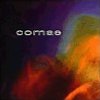 A crackling and an occasional guitar strum, and the gentle rattling of beads. Or so it seems. Again, with sounds that are unusual (initially), comes a desire to identify, rather than simply to listen. The tolling of a miles-away bell, and the scratch and skip of vinyl. These identifications come with curiosity and possible ultimate negligibility. Fittingly enough, the “each”/”remain” time coding on my CD player is not working on these tracks. Unidentifiable sounds, in the end, I suppose.
A crackling and an occasional guitar strum, and the gentle rattling of beads. Or so it seems. Again, with sounds that are unusual (initially), comes a desire to identify, rather than simply to listen. The tolling of a miles-away bell, and the scratch and skip of vinyl. These identifications come with curiosity and possible ultimate negligibility. Fittingly enough, the “each”/”remain” time coding on my CD player is not working on these tracks. Unidentifiable sounds, in the end, I suppose.
Bells? Bottles? Synthesizers? A rise, and the swift sonic descent and then a lull, like a leaf so green falling from the tree and falling through other leaves on its inevitable death spiral downwards. It lies quiet a while, then returns with sizzling and spatial lowing. “Pavane” ends the recording with possibly a 16 rpm return to the carefree days of Ravel. I miss liner notes. Don t you miss liner notes? I understand the desire to keep things rather mysterious, but, well, shit. However, in the wise words of the Chinese sage Lo Pan, “You are not put on this Earth to get it”.
But this is not miserable, life-denying sound. It s as if one has just awoken to see a spinning mobile of jewels hung directly and angelic over one’s head.
-David Cotner-
Comets On Fire – Avatar
Label: Sub Pop Format: CD
![]() Setting themselves yet further along the road to retrodom, Comets On Fire‘s Avatar is something of an exercise in remastering the past of all things Garagey, psyched-up and even occasionally Blues Rock. Where the band have contented themselves previously with the fun and frolics a good old freakout can offer in terms of endge of the teeth feedback and seemingly endless bouts of freeform jamming, Avatar is far more structured and places the (alleged) old-fashioned values of melody and soul to the fore. Which is not to say that they’ve become less fond of the churn of overdrive and extended instrumental meltdown, it’s more that these elements now flow out of some well-rounded songs instead, tripping heavily and steadfastly from lyrical schemas into the realms of rockout.
Setting themselves yet further along the road to retrodom, Comets On Fire‘s Avatar is something of an exercise in remastering the past of all things Garagey, psyched-up and even occasionally Blues Rock. Where the band have contented themselves previously with the fun and frolics a good old freakout can offer in terms of endge of the teeth feedback and seemingly endless bouts of freeform jamming, Avatar is far more structured and places the (alleged) old-fashioned values of melody and soul to the fore. Which is not to say that they’ve become less fond of the churn of overdrive and extended instrumental meltdown, it’s more that these elements now flow out of some well-rounded songs instead, tripping heavily and steadfastly from lyrical schemas into the realms of rockout.
A case in point is opening track “Dogwood Rust”, which starts all Hard Rock and grunting heartily before ending with a more Stoner vibe, riding on riffs crested with sprinklings of delicate electric guitar. “Jaybird” continues the dynamic, starting off mellow with subtle spurts of analogue synth underwriting the continuing psych groove, adding interference patterns of electronics to the glimmering aura of blissed out good-times Rock’n’Roll and some hash-browned guitar noodling. This song is a prime example of the Comets at their swooning best on Avatar – still spinning out but reining in the tendency to scrape skulls as previously evinced by Blue Cathedral‘s more head-melting moments. Here the method is to start gently, and building on the solid foundations gradually until freakout speed is acheived, taking the stratospherics back down into a steady glimmer of melody and fluttery top end.
So it proceeds for the rest of the album, pretty much. By the time closing cut “Hatched Upon The Age” finishes proceedings with a coruscating swing of steadfast rhythms, the vocals have taken on a Bluesey rasp, and the album has become as familiar and well-worn as an old cardigan, while remaining equally pleasant and satisfying to relax into with good company, a comfortable chair (or bean bag more appropriately) and maybe a fine tipple of choice to hand. For better or worse, Avatar is destined to be a classic Rock album of sorts, enveloping and immensely enjoyable, but never breaking the slightest patch of new ground – nor even pretending, or needing, to do so.
-Linus Tossio-
Chris Connelly – The Episodes
Label: Durtro Jnana Format: CD
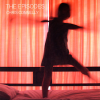 Ex- of Scots industrial dance pioneers Fini Tribe, Chris Connelly is probably best known for his work with Ministry and Revolting Cocks, though his CV is a veritable Who’s Who of industrial music through the 90s, encompassing work with KMFDM, Pigface, Murder Inc and The Damage Manual. So those unfamiliar with his more melodic stuff might be expecting something a lot, well, shoutier and grindier than this. Instead of the head-spining-round-and-vomiting-cos-Satan’s-in-it growls and shrieks of his work with RevCo and Ministry, his voice, when allowed to actually play with tunes, proves to be remarkably Bowie-esque, and he has a similar love of the faded joys of the carnival.
Ex- of Scots industrial dance pioneers Fini Tribe, Chris Connelly is probably best known for his work with Ministry and Revolting Cocks, though his CV is a veritable Who’s Who of industrial music through the 90s, encompassing work with KMFDM, Pigface, Murder Inc and The Damage Manual. So those unfamiliar with his more melodic stuff might be expecting something a lot, well, shoutier and grindier than this. Instead of the head-spining-round-and-vomiting-cos-Satan’s-in-it growls and shrieks of his work with RevCo and Ministry, his voice, when allowed to actually play with tunes, proves to be remarkably Bowie-esque, and he has a similar love of the faded joys of the carnival.
The Episodes consists of a few (it has to be said, very long) tracks on which he comes across as a Scottish Gavin Friday, crooning his way through extended swathes of what could, for the most part, be a quieter Bad Seeds, or a more psychotic Tindersticks. Or indeed a less psychotic Gallon Drunk. Though the album seems largely to be based around the bluesy grind of “The Son Of Empty Sam”, which comes round in one epic chunk and a later reprise, for me the centrepiece is “Soul Boys/Hard Legends”, which is like Scott Walker‘s The Drift being taken on a Friday night tour of some of the finest drinking establishments Scotland has to offer, and then getting into a fight. It’s all smudged eyeliner and inappropriate glitter smeared across production for which the word “soundscape” is more appropriate than the word “tune”, but which is no less affecting for all that.
So, it’s music for drinking to. I’m well aware that as far as I’m concerned, ALL music is music for drinking to, but to the connoisseur there are as many types of drinking music as there are types of drink. (You can mix and match them to make cocktails, too, which is nice). This is music for drinking to in the cab home, when you don’t know where it’s going and the cabbie is becoming increasingly stressed, and you’re still trying to figure out how your booze managed to get glitter in it. And it’s very good, too.
-Deuteronemu 90210, who’s not as shouty as he used to be-
Cornucopia – .C.
Label: Assemblage Format: CD
Well, it’s packed like the old Inner-X tapes use to be – for me, that’s a big plus. Strange chemical odor emits from the CDR and the attendant plastic packaging, and the sound is somewhat similar – a series of leaks and splashes, with the attendant hum and din of announcements from on-high. The effect is much like the hearing of quiet things from beneath a sewer, or a sidewalk, or a tunnel. It stays at a particularly particulate level and then intensifies – not immediately, but subtly; as though the listener were surfacing through a vast effervescent wet sea of memories and everything that those imply.
-David Cotner-
Couch – Fantasy
Label: Kitty-Yo/Kollaps Format: CD/LP
Yes, yes, it’s more German post-rock from Kitty-Yo and Kollaps stables! I believe I’d labelled a pigeon-hole “more bleedin’ German post-Rock” specifically for this band. It’s not that they’re bad, it’s just that if you have a basic grasp of the operating procedures of Kreidler or To Rococo Rot then you probably do not need this album. Jurgen Soden, who does so much to enliven Schwermut Forest‘s swinging arpeggios has been turned by his bandmates’ sequencing into a damp squib – he is entirely superfluous in this group. His heart just doesn’t seem to be into it as the rest of the band recycle the least interesting phases of recent Electronica. Okay, yes, I understand that this generation of German musicians is reacting against the excesses of Krautrock but they seem to have shied away from its strengths and its passion to become so much studio cardboard.
Bland but well constructed.
-Iotar-
Couch – Profane
Label: Kitty-Yo(CD,Europe)/Kollaps (LP,Europe)/Matador(USA & Australasia) Format: CD,LP
 This is Couch‘s fourth album but the only one I’ve heard. At first I thought it sounding like a collection of backing tracks to which vocals might be added. A sort of superior Karaoke music. The guitar, keyboards, bass and drums don’t indulge in solos so, again, I thought you could add your own over the top. Play along with Crouch. But the more I listen, and it does bear repeated playing, the more the music sounds sufficient in itself.
This is Couch‘s fourth album but the only one I’ve heard. At first I thought it sounding like a collection of backing tracks to which vocals might be added. A sort of superior Karaoke music. The guitar, keyboards, bass and drums don’t indulge in solos so, again, I thought you could add your own over the top. Play along with Crouch. But the more I listen, and it does bear repeated playing, the more the music sounds sufficient in itself.
They play a tight, minimalist kind of Rock with a few Jazzy inflections, using the repetition of motifs to build up different textures and moods. There is a hint of Portishead on “Was Alles Halt” in the form of the sparse keyboard and minor chords. It is hypnotic and makes a little material go a long way. At other times I could hear echoes of Fripp‘s techniques as demonstrated by League Of Gentlemen or even some recent incarnations of King Crimson. “Meine Marke” has gentle guitar and keyboard that wouldn’t be out of place on an early Caravan album, restrained and melodic, but with better sound quality. By contrast “Kurzer Punkt” cranks the volume and intensity up. But it is still the same formula; take a few chords and repeat and don’t let any one instrument dominate. It works.
The quartet are augmented by cello, percussion and cornet but again it’s unobtrusive, so much so that I’m not sure where the cornet appears. But that is part of the point, I think. An understated surprise of an album.
-Paul Donnelly-
Crane A.K. – Pink Eyed Pony
Label: Force Tracks Format: CD,LP
 This is a really nice slice of minimalist House from Germany’s Crane A.K. who are Markus Gniech (AKA DJ Knigge) and Michael Friedrich. Both are integral parts of Berlin’s Techno/House community. Knigge molds his dancefloor technique with Friedrich’s meticulous and crisp production. The result drifts somewhere between Techno and House, the Pink Eyed Pony has all the right Electro tweaks and twiddles and Deep House bass lines in just the right places.
This is a really nice slice of minimalist House from Germany’s Crane A.K. who are Markus Gniech (AKA DJ Knigge) and Michael Friedrich. Both are integral parts of Berlin’s Techno/House community. Knigge molds his dancefloor technique with Friedrich’s meticulous and crisp production. The result drifts somewhere between Techno and House, the Pink Eyed Pony has all the right Electro tweaks and twiddles and Deep House bass lines in just the right places.
I may not have written volumes about Pink Eyed Pony, but how many words do you need to say an album is really good?
-ap-
Cray – Undo
Label: Bip-Hop Format: CD
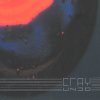 Undo is the second release from Cray, a.k.a. Ross Healy, on the continually impressive Bip Hop label. Undo isn’t the easiest of listening, but we all need a challenge every so often. Ross Healy pretty well does that as he goes about assembling found sounds and chance noises. “The key element in Cray’s music is to experiment with sound and to create sound images”, states Healy. “Over the years I have tried to put less control on my works, as I get very bored with a fixed way of doing music.”
Undo is the second release from Cray, a.k.a. Ross Healy, on the continually impressive Bip Hop label. Undo isn’t the easiest of listening, but we all need a challenge every so often. Ross Healy pretty well does that as he goes about assembling found sounds and chance noises. “The key element in Cray’s music is to experiment with sound and to create sound images”, states Healy. “Over the years I have tried to put less control on my works, as I get very bored with a fixed way of doing music.”
The chaotic sound paintings of Undo are collected from microphones and MiniDiscs and are then layered on computer. The results can be harsh but rarely austere. There is too much flux and change going on for Undo to be austere. Dare I mention Karlheinz Stockhausen? Maybe its inevitable that all abstract electronic worlds refer back to his early electronic pieces. Maybe there is a surface similarity, but it ends there. Stockhausen’s electronics weren’t chaotic. Strip away what appears to be random and you’ll find a structure that’s so all pervasive that it’ll make a Beethoven symphony look like hastily flung together bag of crotchets. Cray’s methodology is wildly different. He works on much more random lines. Chance plays an important role, more important than the musician even. “Everything is meant to be in the music, if and accident happens I leave it in. There is no right and wrong in sound.”
Perhaps it will come as no surprise that Cray is preparing as his next release Zen and The Art Of Hard Disk Recording.
-ap-
Cray – Undo (A Second Opinion)
Soft sizzling like bacon on the grill and does one undo the apron and cook naked? Of course not. Well, I mean, unless that’s your “kink”… but the reaction is to listen closely, more intently to softer sounds, or to ignore it and thereby relegate it to the woeful world of dishwashing music. Slight echoes from further down the cave, underwater and barely lit, and then these beautiful angelic melodies ebb and pulse outward, past the barnacles and the bathyspheres, undulating with every ocean current of sound. As they rise to the surface, their structure erodes – fluttering and fracturing and flooding the air above with a fine luminescent powder…
Those melodies swing low at this point, across a pollen-field of digital tones and scratching from somewhere unseen yet very nearby that leaves a hissing in the ears upon exiting. It’s as if there’s a certain amount of sonic autism extant – as if the composer is moving at much different speeds than his surroundings and peers, and the information gleaned through those passages is processed and reformed at different rates. Many backwards-flitting sounds, no small amount of twittering, and the scent of water fills the air… Do certain sounds also double as aural Rorschach tests, or dream symbols? That is, if there is a certain amount of water heard in a recording, I suspect it works as fuck music, too. If the sound of a hotdog being thrown down a hallway is heard – hey now! The chugging malfunctioning starter motor has its way now, scattering into glass fragments as the band plays on…
-David Cotner-
Crib – Remnant
Label: A True Classical CD Format: CD
Sounds of the locomotive and birds besides (in a faraway way) begin the meditation on travelling and what’s left behind, in the latest incarnation of Devin Sarno‘s Crib, which includes Jeff Gauthier, G.E. Stinson, Nels Cline, Petra Haden, Joseph Hammer, and Britt Randle. This achingly gorgeous series of field recordings and long bass drones and sporadic strings is exactly what you’d get were you to take a tour of California’s central coast, driving along the 101 Freeway. This freeway pokes through the region of Los Angeles to San Francisco, stretching through vineyards and the fields, along dusty lonely roads and past that Amtrak train winding its serpentine way through brown hills scorched by endless summers and the certain total blackness of nighttime without streetlamps.
This is the sound of peripheral awareness of the external world when one is wrapped up in one’s own thoughts and realising that, no matter where one goes in this modern world, there is always the sound of a motor…
-David Cotner-
C-Schulz & Hajsch – C-Schulz & Hajsch (maybe)
Label: Sonig Format: CD,LP
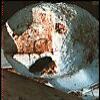 First of all, here a some important facts you need to know:
First of all, here a some important facts you need to know:
- This album is 100% beat free.
- It is the first and only album by C Schulz & Hajsch.
- There are no remixes, live dates, or interviews associated with this album.
- It has no date of expiry.
- It has no title.
Isn’t it great to see a group of people who appreciate Big Black‘s axiom: a good band should know when to split up! After years of lost in production, C-Schulz and Hajsch have teamed up for one and only one album. Making only one album means it has to mean what it says, although it doesn`t say a great deal. It would be all too easy to make a sequel album that is identical with 20 Speed Garage mixes hot on its heels. After all, isn’t that the sad state dance music in particular and electronic music in general has wound up in?
This is an album that gets back to basics. This is ambience in roughly the same sense that Brain Eno used the word. This isn’t a mellow collection of Trip-Hop beats with whooshy bits. Messers. C-Schulz and Hajsch produce some series Ligeti-length drones that meander in and out of microtones. This is were diverse instruments meet only to be smudged into an elongated blur.
Albums accompanied with axioms are winners in my book.
-AP-
Gabor Csupo – Liquid Fire
Label: Tone Casualties Format: 2CD
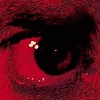 Gabor Csupo, cartoon magnate of this parish, here offers up a double CD of electronic tomfoolery. A double, I hear you say? (Well, actually, I don’t, but I’ll answer anyway). Remember the third season of Lexx, with the Fire Planet and the Ice Planet? It’s kind of like that. Divided into Liquid and Fire, it spans pretty much every end of fucked ambience, from the Coilesque to the “like Enigma if they were better” folk-music sampling tracks like “Neenana Neenana Nina” or “Hungarian Dance #1 and #2” (though Enigma would never have had the balls to play the tricks with time signatures that the boy Csupo gets up to on the latter two.)
Gabor Csupo, cartoon magnate of this parish, here offers up a double CD of electronic tomfoolery. A double, I hear you say? (Well, actually, I don’t, but I’ll answer anyway). Remember the third season of Lexx, with the Fire Planet and the Ice Planet? It’s kind of like that. Divided into Liquid and Fire, it spans pretty much every end of fucked ambience, from the Coilesque to the “like Enigma if they were better” folk-music sampling tracks like “Neenana Neenana Nina” or “Hungarian Dance #1 and #2” (though Enigma would never have had the balls to play the tricks with time signatures that the boy Csupo gets up to on the latter two.)
The track listing is a joy in itself- “The Dark Gloss In Her Teary Eyes” really should have been a Legendary Pink Dots title, and as for “Intergalactic Frog Wedding”- really, this is too eclectic to simplify, so a random selection of influences and impressions is gonna have to do (wanna see my Dick Emery? No, thought not). Eno, of course, is a big presence here (unsurprisingly, listed first on the sleeve notes’ exhaustive list of influences), but the Eno of NerveNet and the like- this isn’t really music for airports. Apart from anything else, all the water sounds on Disc One would have you busting for a piss for the duration of your journey, and “Thrombosis” really isn’t something you want on a long-haul flight. Liquid is the more mellow of the two, but that doesn’t mean it doesn’t have its fair share of headfuck hecticity. Bruce Wagner (the same Brice Wagner, I think, who created the wonderful Wild Palms and wrote the criminally underrated novel Force Majeure) pops up once on each disc to throw in some very fucked, seedy Bukowski-meets-Chandler commentary.
Over on Fire, things are much more Electro, and slightly more abrasive, but still very spacey. Remember the “Robot” bit from Sven Vath‘s The Harlequin, The Robot And The Ballet Dancer? It’s kind of like that, but with the Harlequin and the Ballet Dancer both also in evidence. The Lexx theme is possibly (though it’s probably just me) continued by having a track called “Cluster Bimbo”, all In Gorbachev We Trust-era Shamenesque Acid beats, with nice pulsing synths underneath and a cool line in speaker-swapping snare rolls.
Thirty-five tracks of what used to be called “Intelligent Techno” could, in the hands of many people, be overly long and get quite dull. But there’s enough variation here to sustain your interest. And you just gotta love a track called “Bad Hair-day In Egypt”, which for some reason puts me in mind of someone with a mullet breakdancing in the shadow of the Sphinx. Only in space. Many years back, someone told me they only liked Techno if it was “busy”. I wasn’t really sure what he meant, but this is fucking busy. There’s always at least a godzillion different things going on, so one minute you’re listening to the bass, the next you realise there’s been quite a pleasant tune going on elsewhere, then suddenly out of nowhere a new sampled melody line will come in and kick you in the bollocks. But in a nice way. Oh yes. This is good. Hugely so.
-Here Lies Deuteronemu 90210, Tragically Monstered By Beaks-
Cube & Sphere – Great Norwegian Explorers
Label: Seperator/Disko B Format: CD
Operating in their Drum & Bass guise, Hans Platzgumer and Gerhard Potuznik have delivered a masterfully ironic album containing some of the most chilled breaks and grooves heard in a long time – and chilled here means cold as ice. From the opening arpggiations (which due to their origins on some kind of digital keyboard are pretty frosty and attenuated anyhow) onwards, Great Norwegian Explorers is out to disrupt and dislocate. The track titles are a bit of a giveaway on the mood they’re after – “Amundsen”, “Accidental Suicide”, “Together In Despair” – but these could equally have appeared as labels on an Isolationist piece of minimalist scuttling (though the untitled extra track at the end of the CD presents a more Ambient depiction of entropic weather and/or psychological conditions).
Whatever else it may be, this is not a quiet album. Threatening, discomforting and attenuated are more reasonable adjectives for many tracks here, and some of the basslines and breaks are top class wedges of analogue splurge with cut and paste percussion. For all the mock-Scandinavian gloom on offer (Potuznik & Platzgumer are actually Austrian), there’s a streak of sardonic humour let loose with “Yngwie J. Malmsteen” (who is of course, Swedish). This track is about as un-Hard Rock as can be, and if there are any extended geetar solos lurking around its complex rhythms and ponderous bassline then they’re disguised so heavily as to be a bit of an inaudible in-joke.
Though its production values feel (appropriately enough) a little clean and slightly sterile, the arrangements are never dull or lacking inspiration. Even the rolling Jazz shuffle of “Style Time” has an entropic two-note organ riff to undercut the groove built up by a propulsive shaker beat and refried Funky drumming, making for a rather enjoyably frigid collapsing beat. Likewise “Close To The Edge” constructs a claustrophobic web of breaks into a monumental sweep of Electro shards and belching low-end expulsions which even leave space for the odd scratch or two. No sound Cube & Sphere deploy is particularly unique, but they manage to summon the atmosphere of a bleak, depopulated musical landscape through the brooding bass slides, icy synths sequences and the clatter of stretched percussive sounds (as found on “Into Thin Air”) which resemble the cracking of ice spicules or something equally ominous to have around in the Arctic. A record which uses the tools of digital civilization to represent nature at its most desolate, and one to treasure (if and) when the blistering heat of summer swings by again.
-Freq1C-
Cul de Sac – Crashes To Light, Minutes To Its Fall
Label: Thirsty Ear Format: CD
 If a lot of bands really know how to rock, it must be said that Cul de Sac wrote the book on how to roll. On second thought, Michael Rother probably wrote that book but Glenn Jones and Cul de Sac have studied the manual and memorized all the important parts. This latest CD sees the group again masterfully rolling their listeners through a richly-textured musical commentary on the hopelessness of the earth. Staying away from the clichéd melancholy one might infer here, the band produce a sound which is smooth and variable and just a little lonely. Surely it is that if the times are without hope, then it is a beautiful thing that is being regretted and the pictures ensconced in all this sound are gorgeous. And the rolling sensations are throughout and thorough, guitars, synths, contraptions, all delivery devices well rounded to creating musical smoothness.
If a lot of bands really know how to rock, it must be said that Cul de Sac wrote the book on how to roll. On second thought, Michael Rother probably wrote that book but Glenn Jones and Cul de Sac have studied the manual and memorized all the important parts. This latest CD sees the group again masterfully rolling their listeners through a richly-textured musical commentary on the hopelessness of the earth. Staying away from the clichéd melancholy one might infer here, the band produce a sound which is smooth and variable and just a little lonely. Surely it is that if the times are without hope, then it is a beautiful thing that is being regretted and the pictures ensconced in all this sound are gorgeous. And the rolling sensations are throughout and thorough, guitars, synths, contraptions, all delivery devices well rounded to creating musical smoothness.
Like a fine book or the rare, really great film, Crashes To Light, Minutes To Its Fall seems to change with every listen. The Latin string stylings may once impress with their surf sound wave-rider Baja freedoms, while on another listen these same strings come across more like the bittersweet soundtrack echoes of the (Spaghetti) Westerns that made us all want to be the Lone Ranger, or the bad guys in black. There is definitely a sound of desolation, aural desert type, but without all the saccharine that can make solitude music go ever so sappy. Cul de Sac instead roll from one lush track to the next for over an hour’s worth of sensible examination of the state of things. They seem to be masters in the art of thinking through listening and Crashes to Light is as thought-provoking as they have brought us to expect it should be.
Recorded and produced by Jon Williams over half a year’s time, there is a strong perception of the professionalism and perfectionism of all concerned. There is not one crease in the smooth structure, though it may be noted that this is not a slickly sickly pushed away from origins recording. It is pure and self-evident. Crashes also provides a forum for the unusual in that this music is made from classical instruments, digital ones, and things which would ordinarily not be musical at all. What’s different about Cul de Sac’s blend is the balance they create and the sumptuous folding of one sound with the other so that everything compliments everything. Musicians have been trying out all sorts of materials to create their sounds for years now; mostly when someone hammers a piece of roofing tin, it sounds like someone is hammering a roofing tin. How nice then that Crashes to Light sees the autoharp being as well treated as the skewered superball which is as equally well treated as U.S. Navy practice bombs which are then well treated as the steely guitar strumming, so that nothing is obviously what it is, and at the same time it is clear that the work would suffer even one item being taken away. And Cul de Sac create a language that can make sense to a great many, not in a cross-sectioned, target group retail sort of way, but in finding a commonality of feeling that reaches soul deep and gives enough breathing room so that the listener may decipher their own story from it.
Hopefully in the near future Cul de Sac will be able to solve their distribution and representation ills as far as territories outside the USA are concerned and their entire catalogue be once again wide-openly available in all countries. Until such time, do go to all lengths to include Crashes to Light in your collections. No home should be without one.
-Lilly Novak-
Cul de Sac – The Portland Cement Factory At Monolith, California/Hagstrom
Label: Earworm Format: 7″
 Originally released on the group’s debut Ecim album in 1992 (recorded in 1990), John Fahey‘s”Portland Cement Factory” (along with having one of the best song titles ever) is one of Cul de Sac‘s very few covers, and the version on this single was recorded just down the road from the factory itself for KFJC Radio. In this interpretation, the sound is crystal-clear, the chiming guitars and groovy underlay juxtaposed with grinding Industrial noise in echo of the sound of the factory itself, and one of the greatest moments of interruption which possibly went on to spark such collisions between gentle melodic strings and mechanical noise as Faust‘s “It’s A Bit Of A Pain” and “Pleasant Banjo Intro with Irritating Squeak” from Nurse With Wound.
Originally released on the group’s debut Ecim album in 1992 (recorded in 1990), John Fahey‘s”Portland Cement Factory” (along with having one of the best song titles ever) is one of Cul de Sac‘s very few covers, and the version on this single was recorded just down the road from the factory itself for KFJC Radio. In this interpretation, the sound is crystal-clear, the chiming guitars and groovy underlay juxtaposed with grinding Industrial noise in echo of the sound of the factory itself, and one of the greatest moments of interruption which possibly went on to spark such collisions between gentle melodic strings and mechanical noise as Faust‘s “It’s A Bit Of A Pain” and “Pleasant Banjo Intro with Irritating Squeak” from Nurse With Wound.
Connexions and comparisons aside, the Cul de Sac track here was also issued as a single in a sort of follow-up to their traumatic but exhilarating collaboration with Fahey in 1997, The Epiphany Of Glenn Jones, and the lovingly-packaged 7″ comes with extensive notes on its history, and that of the factory itself. On the b-side is a version of “Hagstrom” from Crashes To Light, Minutes to Its Fall, and here the band make a slow shuffle arise from the aether of delay and rejigged tapes which prefix one of their characteristic rise and fall instrumentals; but projected into more atonal reaches for the duration. Queasy on occasion, when it really gets going, “Hagstrom” develops into quite a ragged stormer, almost bristling with metallic chimes and plastic folds of squirming electronics.
-Antron S. Meister-
Cultural Amnesia – Enormous Savages
Label: Anna Logue Format: LP+bonus 3″CD
 Remember cassettes? You know, those weird little flat box things full of magnetic tape that kept stretching and getting tangled up, and they were like little machines of their own- I mean, yeah, the actual thing you put in your stereo actually had moving parts, how weird is THAT? Yeah, you know, they were those things that you used when you wanted to copy your mates’ records from vinyl- vinyl? Big black circles of plastic, well, funnily enough VINYL actually, with spirals carved into them which you read with a FUCKING DIAMOND??? Yeah, vinyl. That format they had before CDs. What, you don’t even understand CDs anymore? It’s all- what now? MP-whats? Erm… shouldn’t you be in school, anyway?
Remember cassettes? You know, those weird little flat box things full of magnetic tape that kept stretching and getting tangled up, and they were like little machines of their own- I mean, yeah, the actual thing you put in your stereo actually had moving parts, how weird is THAT? Yeah, you know, they were those things that you used when you wanted to copy your mates’ records from vinyl- vinyl? Big black circles of plastic, well, funnily enough VINYL actually, with spirals carved into them which you read with a FUCKING DIAMOND??? Yeah, vinyl. That format they had before CDs. What, you don’t even understand CDs anymore? It’s all- what now? MP-whats? Erm… shouldn’t you be in school, anyway?
Well, back in the day, people used to use these cassettes to put music on. And swap them. And this, bizarrely, was known as tape trading. Good for unsigned bands, of which there were many after punk proved that you didn’t need a big label behind you to make killer tunes. Members of the tape trading subculture included (yes, I’m getting to the point now) Cultural Amnesia, who have finally had some of their stuff cut to vinyl, in the shape of Enormous Savages, nine tracks released over a three-year period back at the beginning of the 80s.
And here it is. What with being the early Eighties, it’s all very lo-fi, meaning a lot of the synth sounds are somewhat akin to those found on the sort of mid-period Portastudio stuff by Psychic TV, and the production’s pretty much non-existent. That said, that’s never been a problem for people like the aforementioned PTV, or even soundscape-heavy bands like the Legendary Pink Dots, whose own collection of early, cheap recordings, the Legendary Pink Box, this is pretty reminiscent of. Vocals ranging from “The Wildlife Of The Tranquil Vale”‘s anguished screeching, to the very English camp of “Kingdom Come” (whose “Dolly I don’t shit miracles” is probably my favourite part of this whole album) and “Sacrebleu”, which is entirely conducted with that weird effect Bauhaus used on “The Man With The X-Ray Eyes”. Musically it’s got a lot in common with the aforementioned Pink Dots, though there are flashes of early Skinny Puppy in there. And my personal favourite, “Blind Rag”, could conceivably have fitted on Throbbing Gristle‘s seminal 20 Jazz Funk Greats.
One of the selling points of this album is bound to be the fact that three of the tracks have lyrics penned by the late John Balance of Coil, but good as these are, their relative star status shouldn’t take the spotlight off the other tracks. Again, my personal favourite is the “non-Balance” Blind Rag, which seems to come from some strange world where Throbbing Gristle and Soft Cell had fallen into the teleporter together and emerged as some strange gloomy industrial-cabaret hybrid. So far, so early 80s lo-fi. However, it doesn’t end there. Early sales of Enormous Savages (on vinyl, naturally) come complete with a mini-CD of new stuff, called, appropriately enough, Little Savage. This carries on the post-punk electronica project with cleaner, more expensive sounds, but still the sense of paranoia and claustrophobia which infused the early stuff, especially on the manic “syst.admin” which sounds, unexpectedly, like an electronic Stump (or possibly a less scatological TISM) – which can be no bad thing.
All this would be something of a curio (though a damn good one) – kind of stuck out of time and neither fish nor flesh – , were it not for the news that it comes in advance of new material currently being prepared. That will certainly be worth hearing, on the strength of a history this rich.
-Deuteronemu 90210, trying to figure out what happened to 8-track cartridges-
Curd Duca – Elevator 2
Label: Mille Plateaux Format: CD,LP
Subtitled Electro-Acoustic Mood Music, the second in Duca‘s Elevator series mixes samples from a wide range of sources into a melange of stumbling ambiences and timestretched fade-outs. Like an Easy Listening re-release CD played with one finger down on the fast wind button, Elevator 2 impinges itself on the foreground through the removal of half the comforting smooth sounds of the mid-range aural pacifiers of lift, mall and toilet cubicle. “Touch” is both the eeriest and funniest track to be abused in this manner, taking Sixties good vibe Motown love song “Can’t Keep My Eyes Off Of You” and slipping it a goldfish memory replacement, resulting an a strange mix of Oval and arsewipe sentimentalism, with the same material re-appearing at an accelerated rate in the hypercut-up “Superfast”.
If it’s not the digital hardware that gets a banging, then samples of scratchy after-dinner party faves are looped and layered into a stuck record of the kind made familiar by Plunderphonic exponents such as Stock, Hausen & Walkman, but without the furiously unsubtle collisions their earlier records usually involved. Jazz- lite, Bossanova Boogie and Swinging smoochers are Duca’s favourite sources, and he manipulates them into a fitful trickle of fragmented riff, beats and the occasional moment of tape-spliced (if actually performed on hard-disc) Rhumba such as “Waterdrums”. The best example of this is the sampled fists blows and groans of “Uaahh”, which makes a brief little groove from the SFX from a beat-em up game, but there’s a kind of Serialist exploration of tinkling glass and pianos too on “Lani P” or “Dream”.
Like taking a strong hallucinogen in any enclosed post-Modern public space, Elevator 2 presents a skewed soundscape of half-familiar songs and musical phrases, filtered through a variable attention span lasting a few seconds to a couple of minutes. If this record were to be put on repeat and shuffle in a shopping centre full of acid heads, there could be some serious psychic fall-out – given that the average trip to a superstore, mall or whatever the next profound method of worshipping at the temple of commerce might be called can slip into just that kind of an experience given the soberest of minds, this record demands just such an experiment.
-Antron S. Meister-
Current 93 – All Dolled Up Like Christ – Live In New York 1996
Label: Durtro Format: 2CD
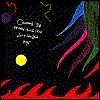 An excellent double set recording the two concerts given over two nights by Current 93 at , New York on All Hallow’s Eve and day 1996, All Dolled Up Like Christ captures the live feel of the group extremely well. However, the live sound is perhaps too clear in its reproduction of the whoops of joy from the audience which greet nearly every song – a problem most pronounced on the first night as presumably the majority of the audience had attended both gigs and had become accustomed to the exhiliration of witnessing one of the few live performances by the band, an especially rare event on the Western side of the Atlantic.
An excellent double set recording the two concerts given over two nights by Current 93 at , New York on All Hallow’s Eve and day 1996, All Dolled Up Like Christ captures the live feel of the group extremely well. However, the live sound is perhaps too clear in its reproduction of the whoops of joy from the audience which greet nearly every song – a problem most pronounced on the first night as presumably the majority of the audience had attended both gigs and had become accustomed to the exhiliration of witnessing one of the few live performances by the band, an especially rare event on the Western side of the Atlantic.
Still, the hardcore fans will love this CD, even with the doubling up of some songs performed on both nights, and add in the gorgeously-designed raining doom gatefold cover (complete with contrasting textures making for subtly pleasing design) and it should by rights fly off the shelves. This is more of an historical document than just a best-of live CD (though it happily serves that funtion too), and in any case there is plenty of fun to be had in comparing and contrasting each take of “Black Flowers Please” or “Dormition and Dominion”. As for “Happy Birthday Pigface Christus” – it become appropriately “…Spooky Moonbeam” or “…Peek-a-Moonbeam” on each night, and both versions are lovely renditions by the ensemble, and somehow this is always a song better performed live than the somewhat stolid single version – the ecstatic screeches, the jangle of the acoustic guitars just work better given the reverberations of a live space (see also the fabulous live performance on “Looney Runes”).
Likewise, “Lucifer Over London”, “When The May Rain Comes” (the best song Current 93 never wrote and cover so evocatively), “A Song For Douglas After He’s Dead”, and the show-ending traditon of blasting out on the ensemble’s epic drone-traum “Christ And The Pale Queens Mighty In Sorrow” – each is a unique moment, and quite, quite a classic, so to hear them live again makes it all flood back from years of performances from South London dancehalls via Walthamstow pub-Rock dives to glorious Islington chapels. Yet again, the live record fills the gap between shows well enough indeed, and with David Tibet‘s fortieth birthday shows imminent, there will be more like this to come.
-Antron S. Meister-
Current 93 – Faust
Label: Durtro Format: CD
 Current 93‘s take on Faust is once again an accompaniment to a literary source, this time Eric, Count Stenbock‘s late Nineteenth Century version of the tale enclosed as a booklet, with artwork by the redoubtably psychedelic Babs Santini. Stenbock was one of the decadent Continental writers resident in London at that most absinthe-enhanced time, and his take on the story enhances the Satanic and macabre aspects, bringing in a little of his own Catholic homosexuality along the way. It’s an eerie read indeed, especially when accompanied by the munching, mouldering, evil-sounding soundtrack Tibet, Steven Stapleton and Andria Degins concoct on the CD.
Current 93‘s take on Faust is once again an accompaniment to a literary source, this time Eric, Count Stenbock‘s late Nineteenth Century version of the tale enclosed as a booklet, with artwork by the redoubtably psychedelic Babs Santini. Stenbock was one of the decadent Continental writers resident in London at that most absinthe-enhanced time, and his take on the story enhances the Satanic and macabre aspects, bringing in a little of his own Catholic homosexuality along the way. It’s an eerie read indeed, especially when accompanied by the munching, mouldering, evil-sounding soundtrack Tibet, Steven Stapleton and Andria Degins concoct on the CD.
The atmosphere summoned is palpably ominous; the aether can almost be felt to tingle under layered moans and monkish chants, almost sneering ghostly voices, chittering noises and the speaking of key sections of the text. A nagging tocsin makes a droning beat, while wheezes, scrapes and the unidentifiable miasma of the unheimlich made aural flesh all combine to meeping, sinister effect. It will be a brave soul who tackles this on headphones in the dark.
As the nights draw up to the Solstice and away, as little piggy Christus gets his once-a-year consumerist bonanza, what better than a wormwood-laced noggin of mulled whathaveyou, the covers pulled up tight to keep the monstrous Id at bay, and a round of weird stories to make the hair stand on end. If the written, better yet, spoken word doesn’t get the pulses racing and the imagination on edge (which it most certainly should), then the music undoubtedly will.
-Antron S. Meister-
(Note: Tibet’s Durtro Press will be publishing a collection of Count Stenbock’s fiction in 2001 )
Current 93 – A Gothic Love Song
Label: Durtro Format: CDS,12″
David Tibet seems ever keener to distance himself from his following of dodgy Goths and over-romantic pseudo-satanists who imagine Current 93 to be far more po-faced than they actually are. The title track is a scathing, if somewhat wistful and sad, put-down on a former girlfriend of the above persuasion and her fake leather tomes of death and gloom. No quibbles with those sentiments, or with the circling, buzzing drones of “Moon”, which sounds like a quartet of saws in the brainpan. Lovely cover, too.
-Antron S. Meister-
Current 93 – The Great In The Small
Label: Durtro Format: CD
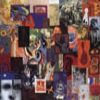 One track, an hour long, packed with every Current 93 recording made from “LaShtAl” in 1983 to Faust in 2000. Plus all of David Tibet’s collaborations with Steven Stapleton that weren’t called Nurse With Wound. And it sounds awesomely dense, as would be imagined – how many recordings in there? thirty, forty plus? The afficionado will have endless fun, sitting with headphones trying to identify each fragment as it collides with another. The diversity of the music, rammed up into close proximity, is very odd to behold; noise collage meets plunderphonic wails and church music, apocalyptic folk strums ride into the eerie drones and wails of the stranger works which lurk below the threshold.
One track, an hour long, packed with every Current 93 recording made from “LaShtAl” in 1983 to Faust in 2000. Plus all of David Tibet’s collaborations with Steven Stapleton that weren’t called Nurse With Wound. And it sounds awesomely dense, as would be imagined – how many recordings in there? thirty, forty plus? The afficionado will have endless fun, sitting with headphones trying to identify each fragment as it collides with another. The diversity of the music, rammed up into close proximity, is very odd to behold; noise collage meets plunderphonic wails and church music, apocalyptic folk strums ride into the eerie drones and wails of the stranger works which lurk below the threshold.
Just imagining the concept is pretty mind-boggling, but the actuality measure up in cacophonous intensity; perhaps this is the template for all Greatest Hits releases to come? And anyone dissatisifed with the Current 93 transformation from brain-blasting wails and vibrant echo treatments of Christianity at song into the more mellow reaches of darkling songsmithery need now have no complaints. The Great In The Small is as immense as could be wished, but just don’t expect anything overmuch more than a multitracked chaos with all the emergent possibilities of mixed-up confusion and (literal) co-incidence that method promises inside.
-Antron S. Meister-
Current 93 – I Have A Special Plan For This World
Label: Durtro Format: CD,12″
 I cannot possibly review this work, I can only relate the events which occurred while I listened. This piece, this lethal bit of truth, is too personal, and does not apply to you.
I cannot possibly review this work, I can only relate the events which occurred while I listened. This piece, this lethal bit of truth, is too personal, and does not apply to you.
Nine minutes or so in, I began to struggle to peel my eyes out from their sockets where they had turned inside out, lodged irrevocably downwards. I did this to look at the counter. Once I had achieved the unfurling of my jellied orbs, I saw that there is only one track, and no indication of its ending… ever. I tried to focus on the clock. By the thirteenth minute I vomited. By the nineteenth minute I wept. Sometimes here and there and now again I breathed. When everyone you’ve ever loved is finally gone, David Tibet‘s speaking of Thomas Ligotti‘s words derived from some nameless, messed-up weirdo’s tapes left scattered thoughout a foreign town over the soundscraped turbulence of Current 93 may come and narrate for you. And if you can bear it, the tapes’ contents are to be found on the B-Side of the clear vinyl edition only. But it’s more personal than that. My shaking hand presses repeat.
-Lilly Novak-
Current 93– Soft Black Stars
Label:Durtro Format: CD, Limited 2LP
A not-quite unexpected turn of events finds David Tibet and friends in contemplative, piano arrangement territory – a logical development from the slow atmospheres of The Innmost Light trilogy. Regret, unfulfilled or lost love, and a healthy distance from the more pretensious aspects of the darker side of artistic endeavour flow wistfully in Tibet’s softly delivered vocals. Accompanied for the most part by Maja Elliot and Michael Cashmore‘s delicately woven pianos and the joint production talents of the group, Steven Stapleton and Christoph Heeman, the twelve untitled songs (save for the single “A Gothic Love Song”) rise and fall in a reflective exposition of times passed and passing.
Although even subtler in its arrangements than The Inmost Light, Soft Black Stars continues the mix of near-sentimentality and evocative wonder at the sadness and pain, glory and transience of existence which has characterised many Current 93 releases since the transition from the Apocalyptic Folk music of the Noddy Apocalypse days. Ageing, dissillusion and the imminence of decay, the meaningless futility of human life are dealt with but not surrendered to – instead, through a process of cathartic confrontation, allowed to step out in a sorry array, before the process of acceptance seeps in at the close. Sometimes this can be unbearably resonant; sometimes even a little close to the self-aware moves of the post-modern poet in a world of Millenial doom and gloom.
Ultimately, Tibet is far too effective a wordsmith for much of this to matter – the eventual conclusion is as a totality of mood, colour and texture, constructed into a melancholic but engaging condensation of what Current 93 have been and can be. Soft Black Stars is a work which shows that, whether the methodology is Industrially noisy or softly spoken, their sound fills space and demands satisfaction from time itself as few others in the twilit world of the black-clad absinthe drinkers can.
-Antron S. Meister-
Current 93 – Sleep Has His House
Label: Durtro Format: CD,2LP
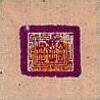 From the simple opening strums of Michael Cashmore‘s guitar and the flowering of the sound into the harmoniums which run through the record as a repeating motif of time held at bay, Sleep Has Its House flows with a melancholic sensibility of an extraordinarily moving kind. Dedicated to, and marking the death of David Tibet‘s father, the songs and instrumentals of this record combine suitably slow descents and rises of drone and repeated chords with his subdued, near-spoken vocals. With typical eye for idiosyncratic detail, this is probably the first Current 93 record Tibet has designed to have not one speck of black about its packaging, perhaps as a small turning away from the rituals and literatures of death which the group are often associated.
From the simple opening strums of Michael Cashmore‘s guitar and the flowering of the sound into the harmoniums which run through the record as a repeating motif of time held at bay, Sleep Has Its House flows with a melancholic sensibility of an extraordinarily moving kind. Dedicated to, and marking the death of David Tibet‘s father, the songs and instrumentals of this record combine suitably slow descents and rises of drone and repeated chords with his subdued, near-spoken vocals. With typical eye for idiosyncratic detail, this is probably the first Current 93 record Tibet has designed to have not one speck of black about its packaging, perhaps as a small turning away from the rituals and literatures of death which the group are often associated.
The instrumental close of “The Magical Bird In The Magical Woods” drifts away on the production tricks of Steven Stapleton, with all the attendant electronic treatments and subsurface mysteries that implies; and there are brightly shining trumpet sounds among the more familiar glockenspiels and chimes of “Red Hawthorn Tree”. But above all is the drone and swirl of the reeds of the harmonium, the sometimes obscured piano chords and rolling orchestrations of bass guitar and sundry instrumentation, the questions and reflections of a son for the father departed, for the sadness of the world. This emotion reaches its peak on the title track, a twenty-five minute paean of cycling pity for the dead which is anything but pitiful, instead makes aching expression, outpouring, summation of the void which bereavment brings in the combined rise and fall of the hypnotically pumped air chambers, the musings of Tibet on the micro-macrocosmic implications of a death.
And with “The God Of Sleep Has Made His House”, an adaptation of John Gower‘s Confessio Amantis, the record closes with the repeated word of the title into silence and a recognition of the finality of all lives. Sleep Has His House may be Currnet 93’s most heartfelt work among their many records of diverse moods, a slow marking of the indefatigable trickle of time. However, there is never a feeling that Tibet is wallowing in his misery about this album, but riding the entropic wave into something approaching calm acceptance. Often disquieting in the obscure and obvious truths it exposes, Sleep Has His House is above all honest in its emotion and utterly effective in its musical depiction of what in other hands could become Gothic clich�of the most dreary kind.
-Antron S. Meister-
Current 93/Antony & The Johnsons – Immortal Bird/The Cripple And The Starfish
Label: Durtro Format: CDS,7″
 Antony has one of the most remarkable androgynous vocal styles of anyone this century, with a range which drips emotion of anything but easy, commercial platitude. He could probably sing opera, soar above the clouds, trawl the depths of human interrelationships with the best of the Blues singers, set torches flaming or belt out show tunes for the gay scene – anything at all. And what a song this single presents; “The Cripple And The Starfish” sometimes screams with saxophones from the backing Johnsons team, springs string sensations and rolls drum and cymbals from the cabaret to the concert hall and back, but despite the testing associations these musics too often reveal, the power of it all, the edgy scars, the oxymoronic interface of love and hate, pain and pleasure make this all so real, and hence workable. Any accusations of kitsch dissolve in a wave of transcended unpleasantness, as indeed does cynicism, musical or otherwise. Staggeringly beautiful.
Antony has one of the most remarkable androgynous vocal styles of anyone this century, with a range which drips emotion of anything but easy, commercial platitude. He could probably sing opera, soar above the clouds, trawl the depths of human interrelationships with the best of the Blues singers, set torches flaming or belt out show tunes for the gay scene – anything at all. And what a song this single presents; “The Cripple And The Starfish” sometimes screams with saxophones from the backing Johnsons team, springs string sensations and rolls drum and cymbals from the cabaret to the concert hall and back, but despite the testing associations these musics too often reveal, the power of it all, the edgy scars, the oxymoronic interface of love and hate, pain and pleasure make this all so real, and hence workable. Any accusations of kitsch dissolve in a wave of transcended unpleasantness, as indeed does cynicism, musical or otherwise. Staggeringly beautiful.
Current 93‘s “Immortal Bird” is a version of the song from Sleep Has His House, wafting chimes and spinning near-static drones at the backdrop to the question “What drives us on?” in the face of a slowly turning, changing world. A lure for fans into hearing Antony & The Johnsons self-titled debut album on Tibet’s own Durtro label too (and so perhaps many will need something to persuade a listen to such apparent musical regularity), this song cycles siderealy, marking a new phase where time slows and recedes into the interplay of reeds and harmonic overtones.
-Linus Tossio-
Current 93/Nurse With Wound – Bright Yellow Moon
Label: United Durtro Format: CD
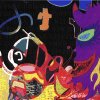 This is the first album released as being by Current 93 and Nurse With Wound, but this is perhaps more a matter of definition than reflecting a specific line-up. Steven Stapleton and David Tibet have appeared on each other’s records throughout their two decades of pottering disturbance, so maybe the intention here is to highlight the atmospheres to be found on Bright Yellow Moon. Recent Current 93 releases have been in-depth explorations of the existential concerns of David Tibet, most often presented inthe form of quieter and quieter songs, with the recording tricknology of Stapleton taking a back seat for the most part (though for example both Faust and I Have A Special Plan For This World disprove that particular conjecture).
This is the first album released as being by Current 93 and Nurse With Wound, but this is perhaps more a matter of definition than reflecting a specific line-up. Steven Stapleton and David Tibet have appeared on each other’s records throughout their two decades of pottering disturbance, so maybe the intention here is to highlight the atmospheres to be found on Bright Yellow Moon. Recent Current 93 releases have been in-depth explorations of the existential concerns of David Tibet, most often presented inthe form of quieter and quieter songs, with the recording tricknology of Stapleton taking a back seat for the most part (though for example both Faust and I Have A Special Plan For This World disprove that particular conjecture).
With lyrics written while Tibet was on what he felt to be his death bed during a near-fatal ilness at the end of 2000, Bright Yellow Moon opens with the reflective melodies of “Butterfly Drops”, and closes in similar mood with the dreaming love song of temporal bliss “Walking Like Shadow”. These simply-structured narratives on the transience of life and the imminence of death book-end an album which delves further into the hallucinatory textural soundscapes for which both Current 93 and NWW were both highly regarded in the years previous to their recent interest in more apparently musical forms. This is not to say that these descriptions are definitive or complete, and are more general than specific; neither group has one fixed sound by any means.
In any case, “Disintegrate Blur 36 Page 03” has the hallucinatory sound of brushed cymbals, echoing guitar notes, slow-turning tones and the sound of shallow respiration to set the journey into the chaos of noise afloat – a stillness before the energetic evocation of the spiralling voids of life and death, reflections in paralysis under the threat of an end on the means and meanings of avoidance, of return. Through the main body of the record, this is expressed through distorted vowels, the rhythmic thrum of virtual and sampled helicopters and steam engines, pitch-shifted, timestretched voices of angels and/or demons. From the confusion of a Blues voice loop informing “you gotta go to Hell on the Black Diamond train” to the imprecations of salvation from the British Legion via the switching cross-echoes and chittering subconscious talk of incubi, the build up is deftly-constucted. A genuine sense of half-terror, half-welcome for the transition to death is apparent, as is a feeling of triumph over the abyss, delivered through an excoriating expulsion of bile and humours in enveloping noise.
 The attention to incidental small sounds is vital to the construction of the whole in Bright Yellow Moon; the wheeze of aetherial hosts, the slow stroke of a low string, a crisp delay pattering to silence among the eventual cacophony. The composition and recording the story of Tibet’s delivery proceeds with his vocal intonations, reflecting on the last words of a fellow patient in “Mothering Sunday (Legion Legion)” as a sound poem which leaves no metaphysical stone unturned in the description of a scene of death, accompanied by spot effects and samples of lysergic intensity. For Tibet to share this close a brush with the end is at once unnerving and engaging, and the trip is by no means an easy one. The reflective patters, shudders and distant echoed cries bring relative quietude to slumbering pass through “Die, Flip Or Go To India”‘s renewal of half-waking, waiting memories. As the groans and words merge with electronics atmospherics, halting percussive rhythms and glitches, there is a fateful invocation in the decay of Tibet’s words “When I cross that sea is not known” into finely-crafted incoherence.
The attention to incidental small sounds is vital to the construction of the whole in Bright Yellow Moon; the wheeze of aetherial hosts, the slow stroke of a low string, a crisp delay pattering to silence among the eventual cacophony. The composition and recording the story of Tibet’s delivery proceeds with his vocal intonations, reflecting on the last words of a fellow patient in “Mothering Sunday (Legion Legion)” as a sound poem which leaves no metaphysical stone unturned in the description of a scene of death, accompanied by spot effects and samples of lysergic intensity. For Tibet to share this close a brush with the end is at once unnerving and engaging, and the trip is by no means an easy one. The reflective patters, shudders and distant echoed cries bring relative quietude to slumbering pass through “Die, Flip Or Go To India”‘s renewal of half-waking, waiting memories. As the groans and words merge with electronics atmospherics, halting percussive rhythms and glitches, there is a fateful invocation in the decay of Tibet’s words “When I cross that sea is not known” into finely-crafted incoherence.
One of Tibet’s visions when close to death was to bring together his entire body of work in one place, and this was done as The Great In The Small. Arguably, what Bright Yellow Moon does is to condense the obsessions and interests of an artistic lifetime, from the looped noise days of Dogs Blood Order via the shimmering questions of Imperium to the still-wondering timeless songs of Soft Black Stars. Together Tibet, Michael Cashmore and Stapleton have marked another epoch in their unique telling of the human story.
-Antron S. Meister-
Postscript:
 Initial mail order copies of Bright Yellow Moon include the four-track remix CD titled Purtle. This has the alternate version “Walking Like Shadow II”, which finds Tibet in fuller voice; “Nichts II” provides an alternative sonic apocalypse of squitters, passing low vehicular rumbles and horripilating electronic vocal winds; while “Disintegrate 36 Page 00” holds back the drama and lets the interplay of string drones and breath chime eerily with the cymbals. Lastly, “Disintegrate 19 Page 03” cranks up the reverberations and breathing among a curtain of descendances, blips and garbled voices, throbbing out into nothing with a pulsing, sleepy flourish.
Initial mail order copies of Bright Yellow Moon include the four-track remix CD titled Purtle. This has the alternate version “Walking Like Shadow II”, which finds Tibet in fuller voice; “Nichts II” provides an alternative sonic apocalypse of squitters, passing low vehicular rumbles and horripilating electronic vocal winds; while “Disintegrate 36 Page 00” holds back the drama and lets the interplay of string drones and breath chime eerily with the cymbals. Lastly, “Disintegrate 19 Page 03” cranks up the reverberations and breathing among a curtain of descendances, blips and garbled voices, throbbing out into nothing with a pulsing, sleepy flourish.
Current Value – Bass Riot
Label: Position Chrome Format: 12″
Current Value follows his debut album Frequency Hunt with an appropriately-titled A-side which kicks straight into the spasming breakbeats and a ominously whirling set of machine detritus and echo. The are some dynamic rhythms at workin “Bass Riot”, chopped up to maximise the approach of the 303 squelches and bass drops which make for a pretty evil little floor-sweeper if ever there was one. Tailor-made for the chemically-enhanced, this is Drum & Bass made to freak out to – just like it should. “Untitled Master” is a less aggressive track, ticking over with portentious menace, the layers of accumulating percussion edging close to grinding repetition, before saving themselves with a chilled drop-out section and a set of Electro ghost-noises, before a return to the tyranny of the loop.
-Freq1C-
Current Value – Frequency Hunt
Label: Position Chrome Format: CD, 2LP
Filtering through an electronic fog with the assurance of an unfolding planetary explorer, the digitally-generated drums, bass and loops of Current Value’s debut album glitter with an otherness, an alien conviction which bears only passing similarity to the usual processes of abstracted breakbeat science. Like the otherworldly Trance music of Eat Static, Frequency Hunt’s title track opens minds and engulfs the body, probing and disrupting – though here the mood is not so friendly. Emotionally much colder, the destination is not ecstasy through euphoria so much as dislocation via immersion in technological sound structures.
Titles such as “Knifesharping”, “Metamorse” and “Asexual Enemy” convey the mechanistic dread which the music evokes, placing it firmly between the cyberparanoia of the Techsteppers and the martial abstraction of Photek. Never reaching any particular emotional level, the affectless scuttling of the hi-hat rolls conjures insectoid menace, with a stark Lovecraftian undertow of uncaring synth swells and disjointed, fractal bass. The listener is rendered almost superfluous by the absence of feeling – and the producer as anonymous as the collective intelligence of a colony of ants – eavesdropping on an ongoing cybernetic process, rather than an overt work of human artistry.
Despite the coldness, there is much to engage with on a more physical level – the arrythmic, scattered bassdrum, timestretched, deftly placed cymbals and the brooding, extended bass of “Coron 174” emerge as exoskeletal glitches in a cyborg framework. As with performance artist StellArc, who places his body at the mercy of MIDI controllers, the listener is subjected to violent lurches in several dimensions simultaneously, with expectations of rhythm and linearity thoroughly disrupted. Truly futuristic (for the moment at least), Frequency Hunt provides an insight into what it may be like to be only partially human, and more mechanical insect than flesh.
-Freq1C-
Current Value – Seeds Of Mutation
Label: Position Chrome Format: CD,2LP
Current Value, Source Direct. Source Direct, Current Value. The comparison is inevitable, both have many similarities, they are well crafted, they meet around the intelligent edges of the Hardstep abyss – or Techstep as someone has called it (marking out a sub-genre of a sub-genre). And, of course, both turned up for review in Freq at roughly the same time. Overall, I`d have to say Current Value comes out on top. Source Direct are good, superb at times, but they can tend to be rather anonymous. Not so Current Value, his Drum and Bass has character machine etched all over it.
To say Seeds of Mutation rocks doesn’t do it justice. It does rock, but that hardly implies the quality of this album. The music is driven by a punchy scrap yard of rhythm clashing with some brilliant moments of epilepsy. If this was a record I’d think about giving the needle a fluff removing blow, but it’s a CD, and it still sounds raw like barbed wire growing out of the speakers. Nasty bass lines that sound strait out of 8-bit tone generators do their wobbly Hardstep stuff. Current Value likes his floating chords, and they hang above the music for most of the album like a cathedral phasing in and out above the spasmodic sea of rhythm.
This isn’t drum and bass you hear every day. Current Value has pulled of one of the great Drum and Bass experiments of the year. Hes taken Hardstep, pushed it further than it ever knew it could go, and done some rather sinister things to it in the process. It’s incredibly mechanical sounding, yet still retains individuality. It’s haunting, grating, intricate, banging, clubbable, Sunday afternoonable, and above all damm good. Is it possible to overstress this point? If Ligeti collaborated with a corrupt hard disk on a Drum and Bass project this is what the result might sound like.
-Alaric Pether-
Cursor Miner – Remote Control EP
Label: Lo Recordings Format: 12″
Combining cut-up laptop electronics with a knack for vocal Pop quirks, “Remote Control” comes on like a channel-hopping deviant singing to his robots from the comfort of his secret living room laboratory. Stuttering beats bleep, schlep and shuffle around each other with the perky mania of a laid back Electro surrealist, at once sad and bouncy and concerned with chocolate eclairs. There’s a synamic glint of mischeivous melancholy about Cursor Miner which somehow suits the idea of an army of clones singing (or sweeping even) along to the micro-swatched sequences, as “One Step Removed” thumps up the pace to a burbling bass wobble.
Time signatures get very woozy here, or maybe it’s just a side effect of cross-cut rhythms polluting each other under the eerie strains of phasing electronic set to a spin cycle from the Eighties. Bizarre enough as that is, “Snapped Capacitor” fractures into a sharp-edged virtual Dancehall pulse of considerable urgency, all the time squeaking underneath like it needs oiling as the bleeps assert themselves. Finally, “Thaw” skates around on cheery blades of melody, trilling for all its heartwarming worth to the strains of an electronic harpsichord like the closing titles to a Sixties tale of space-age love and bachelor pad redemption.
-Linus Tossio-
